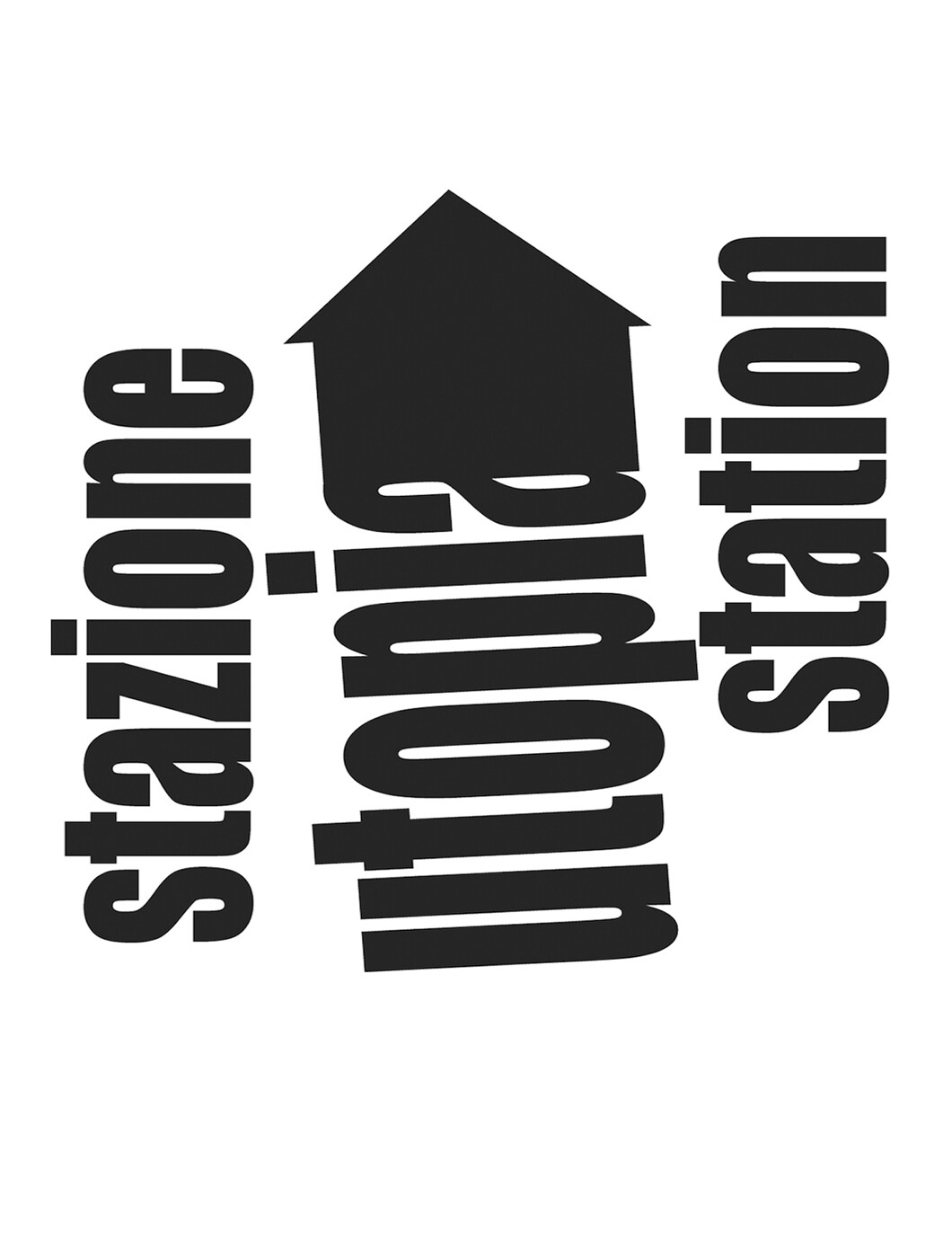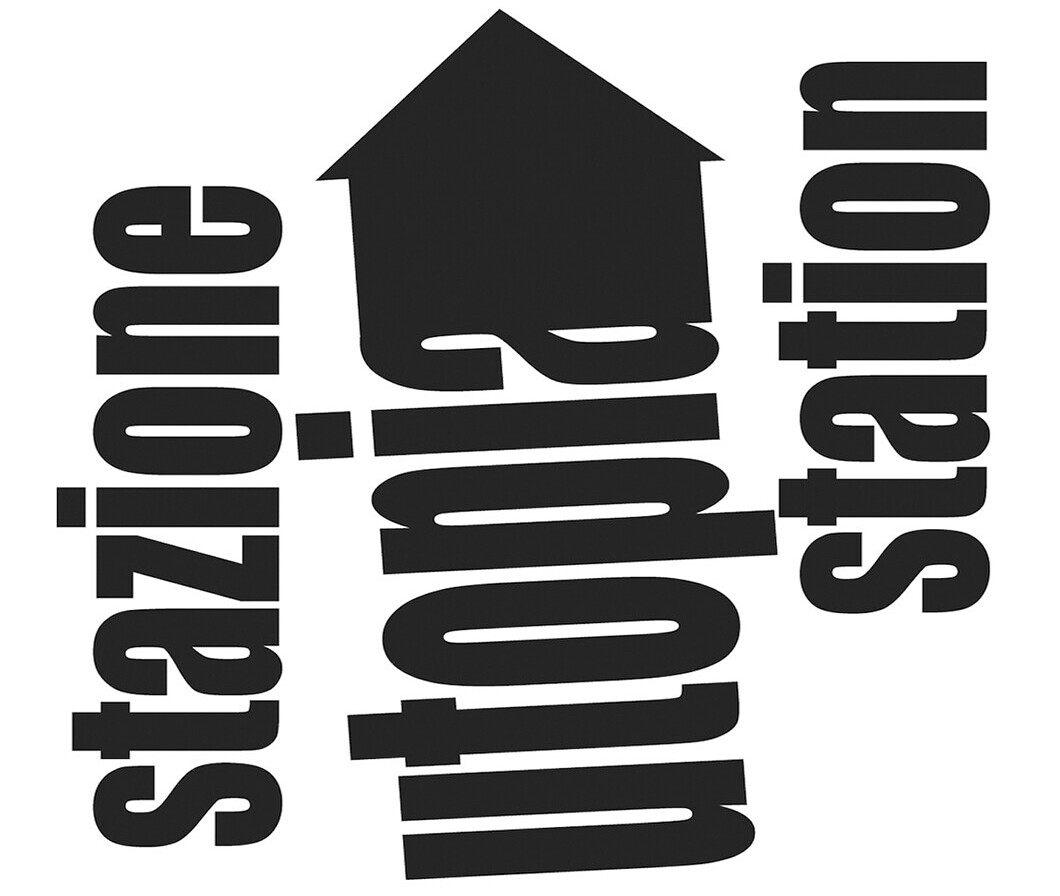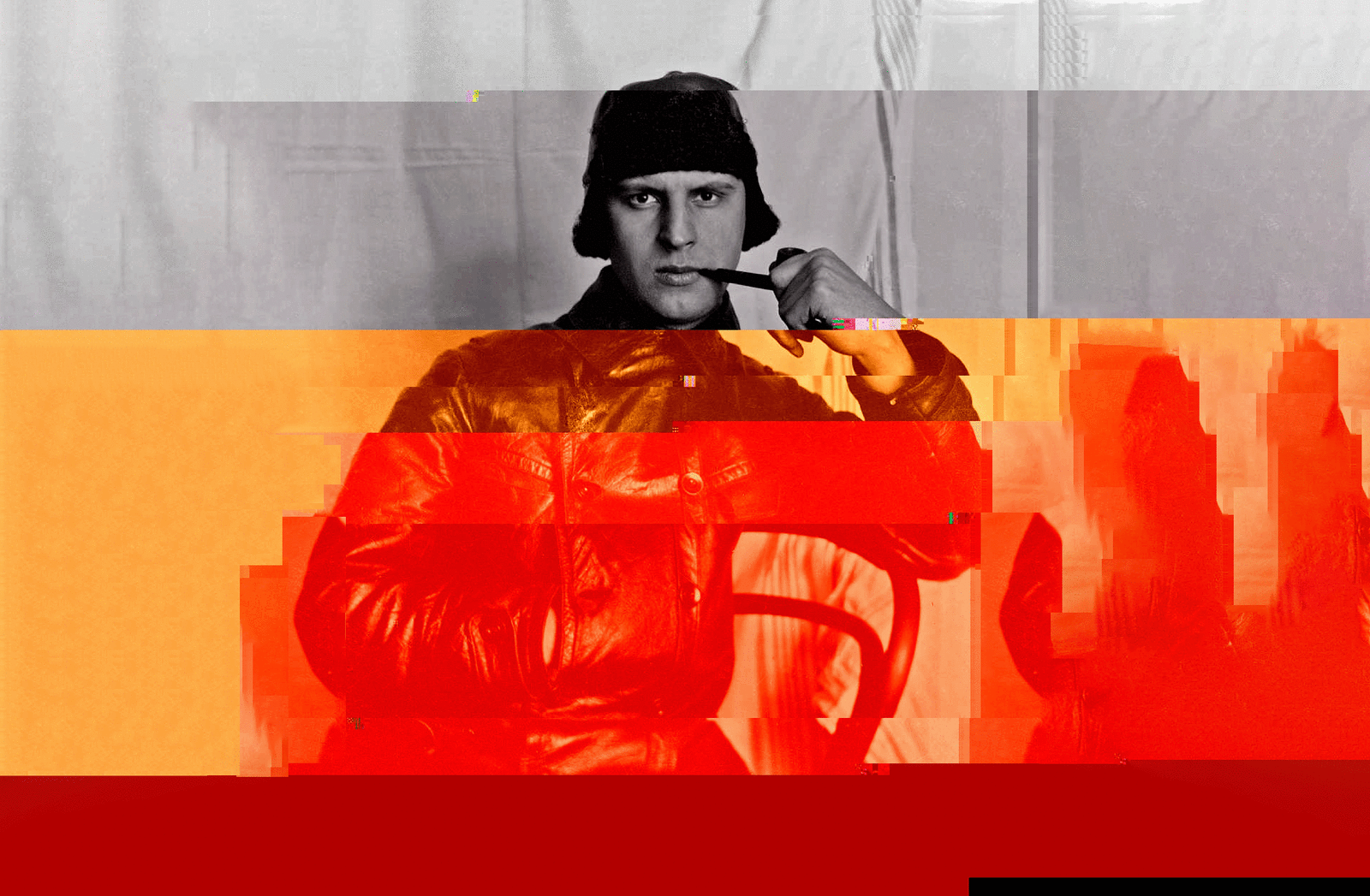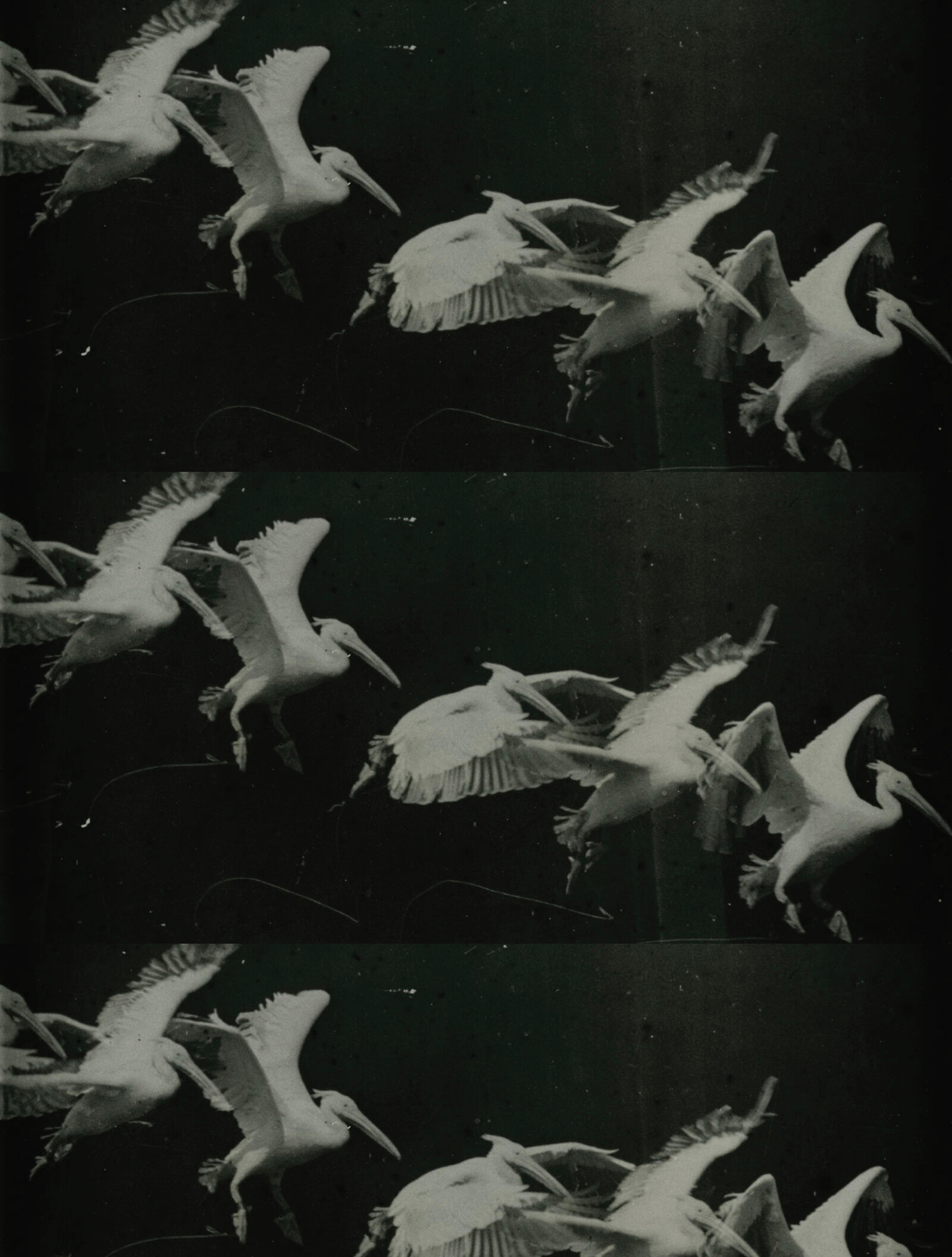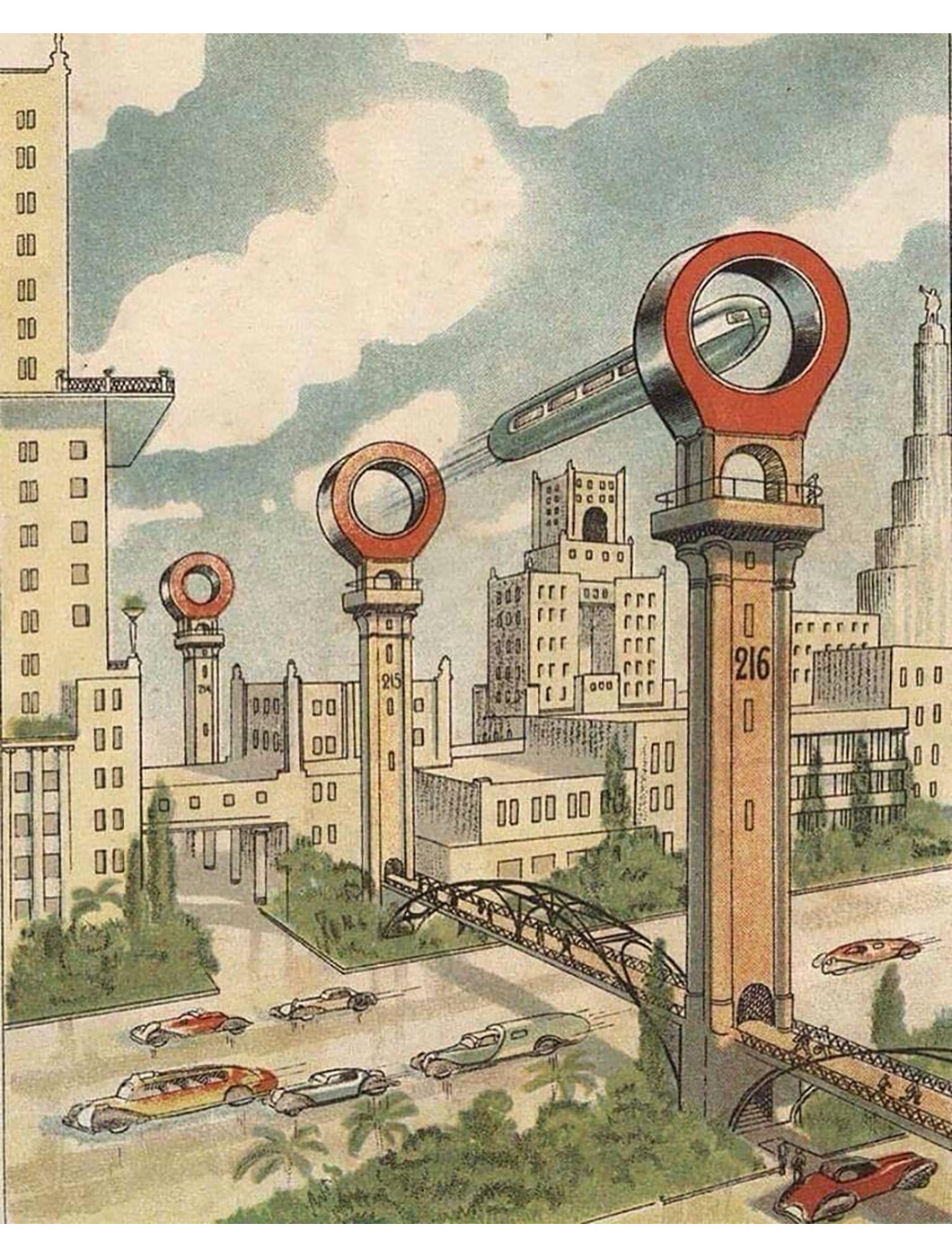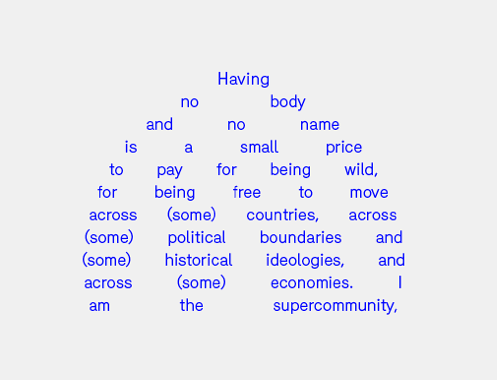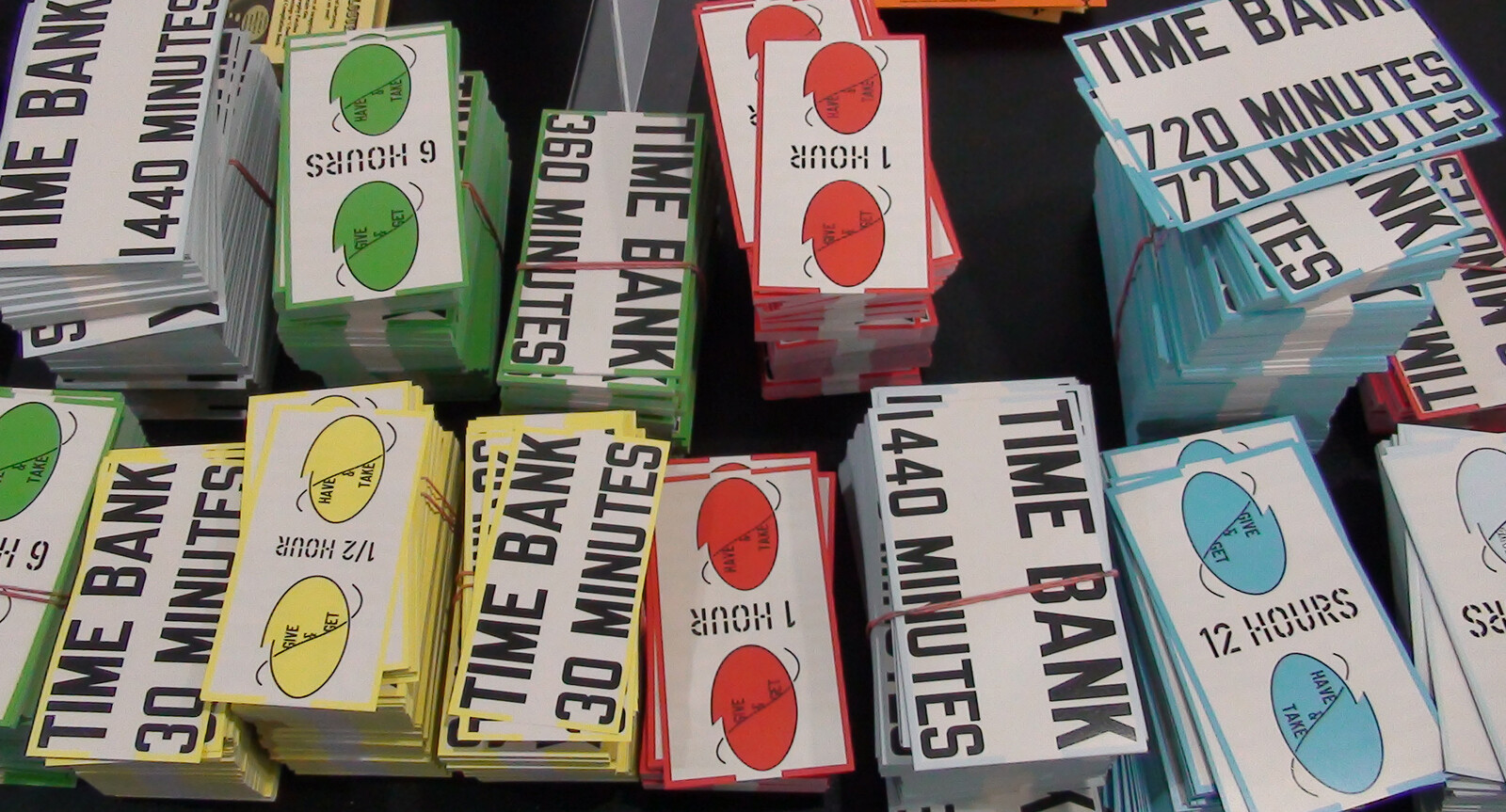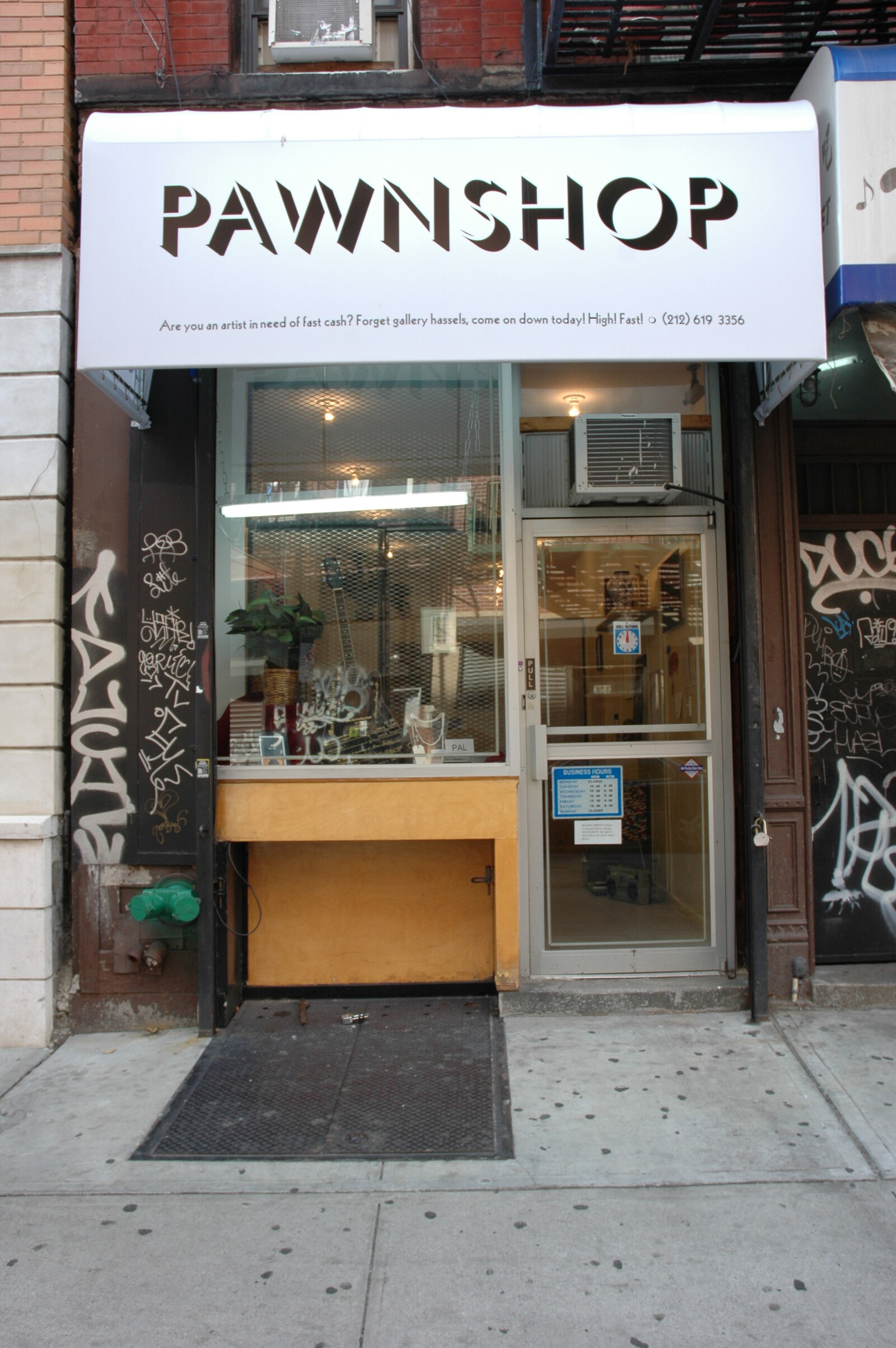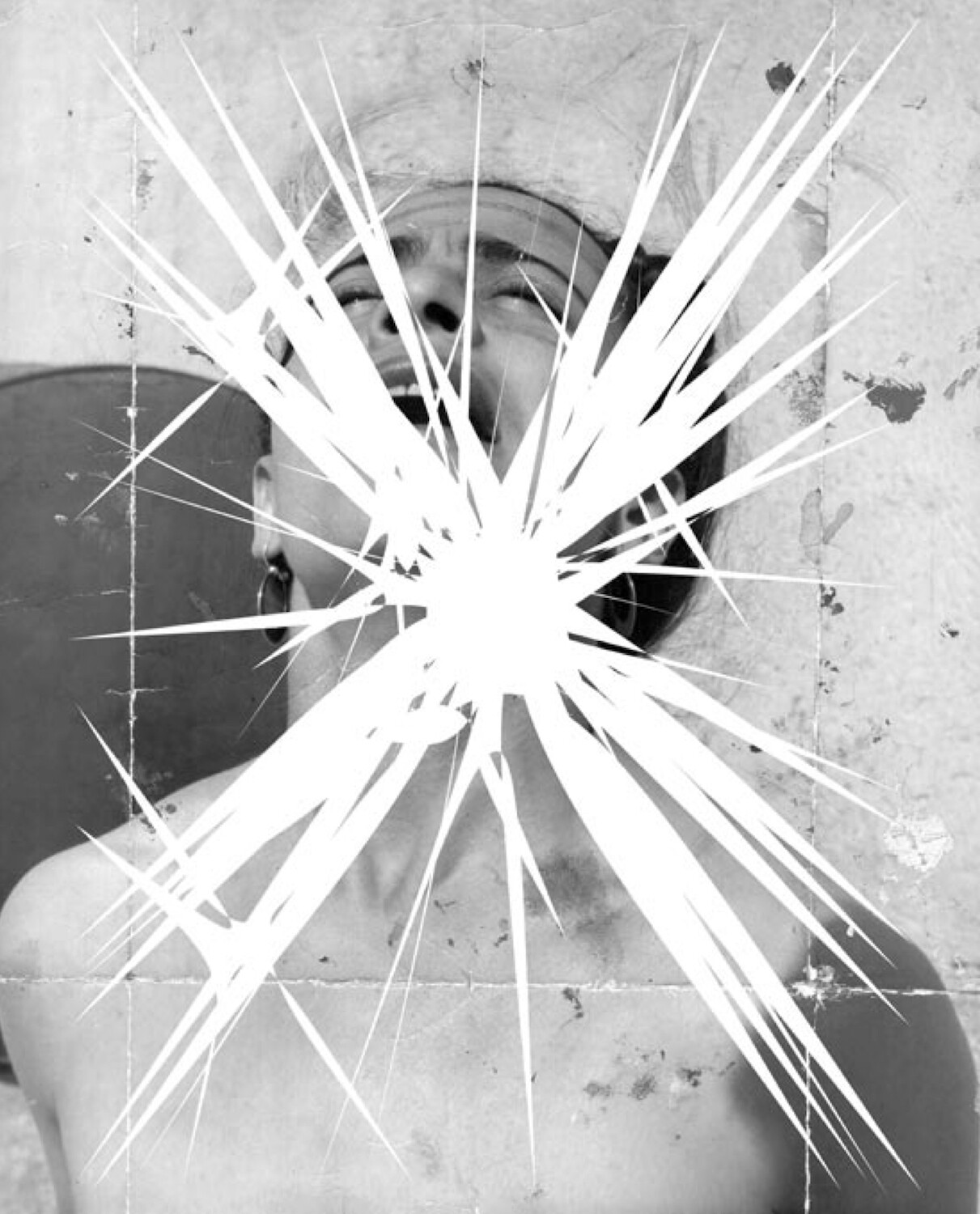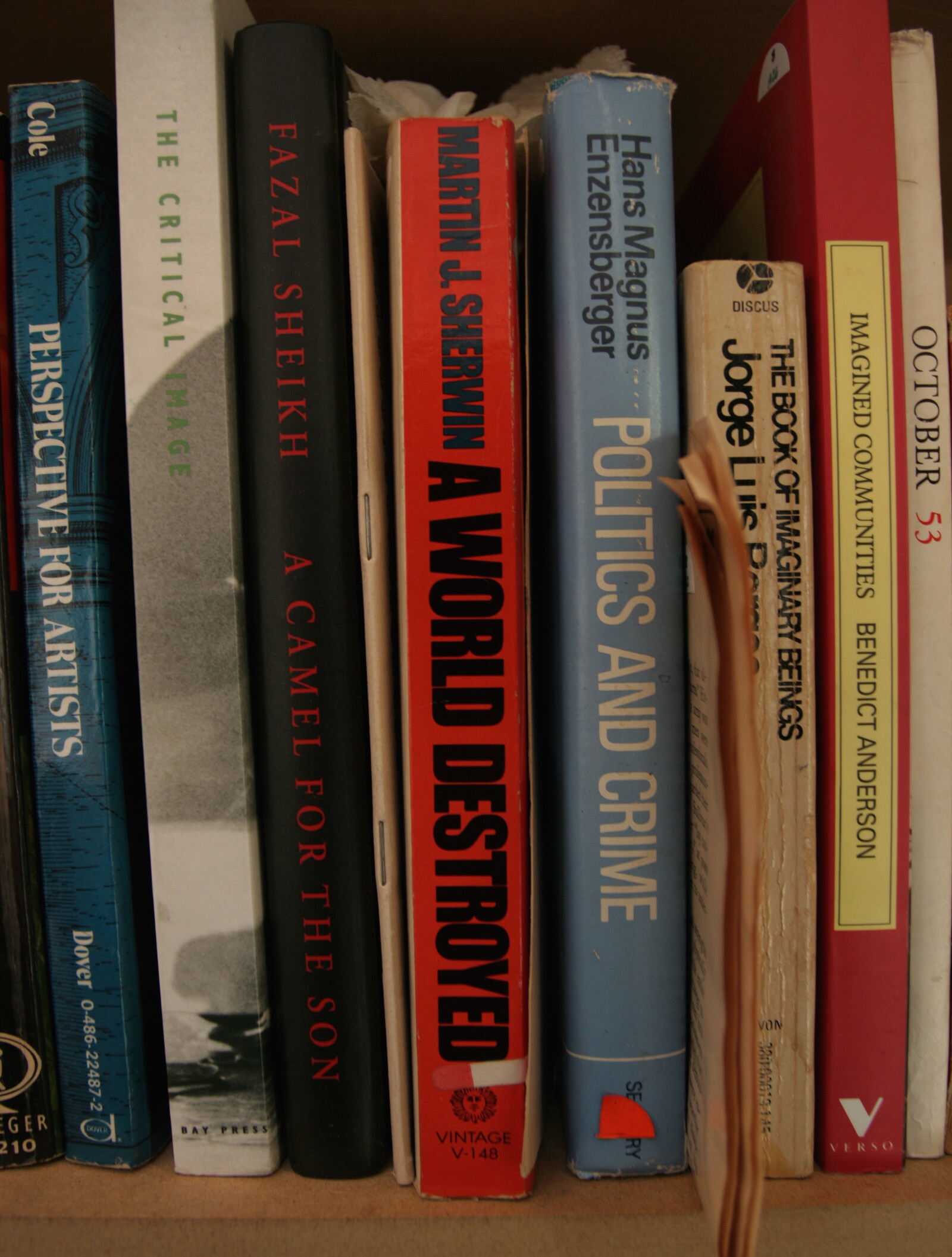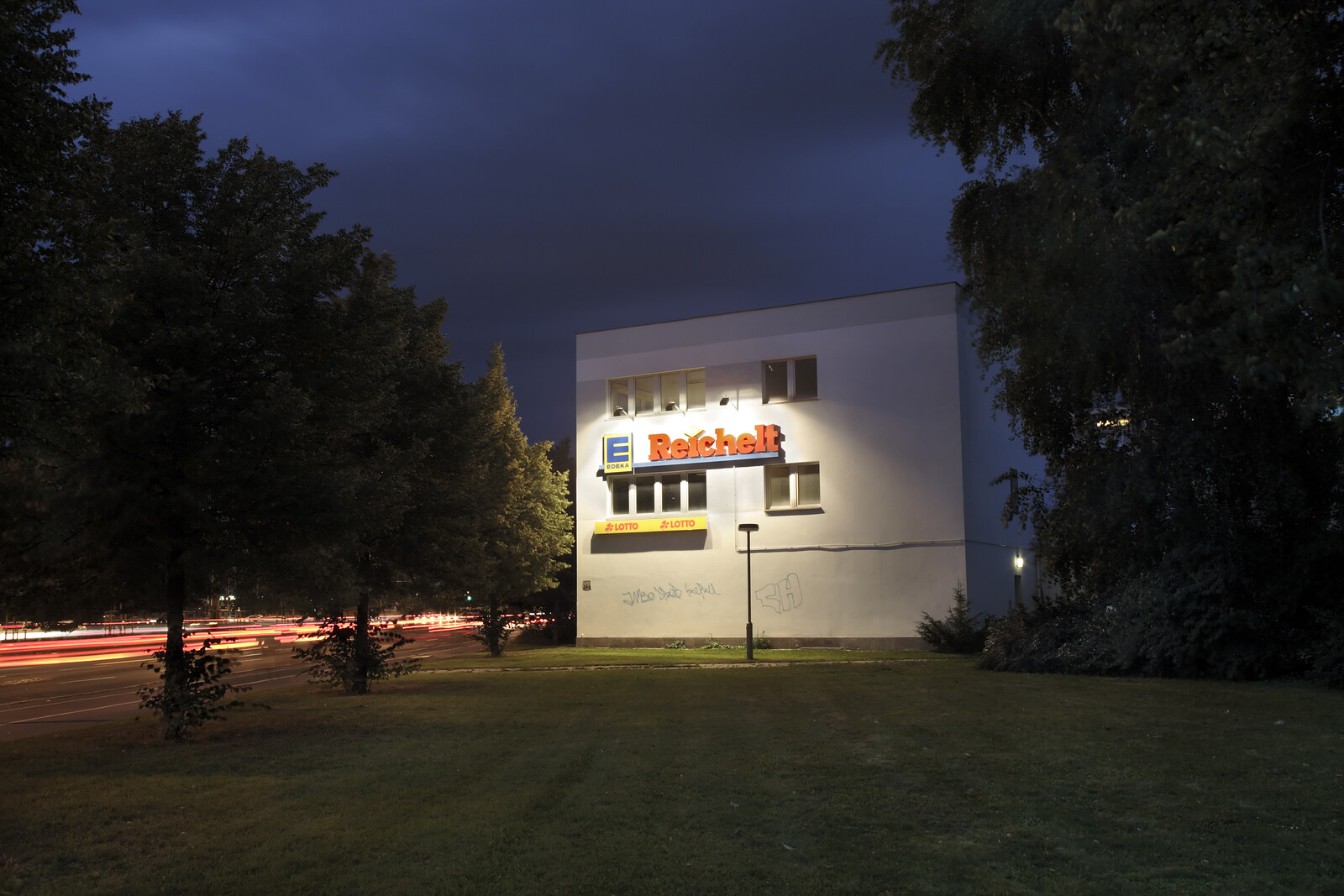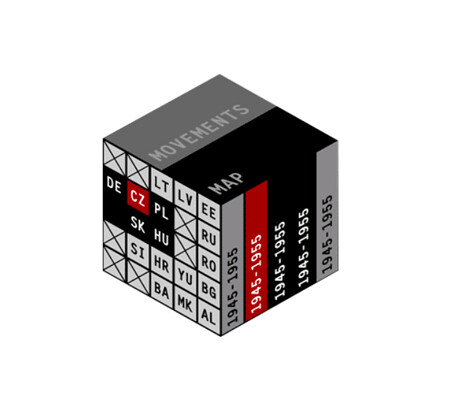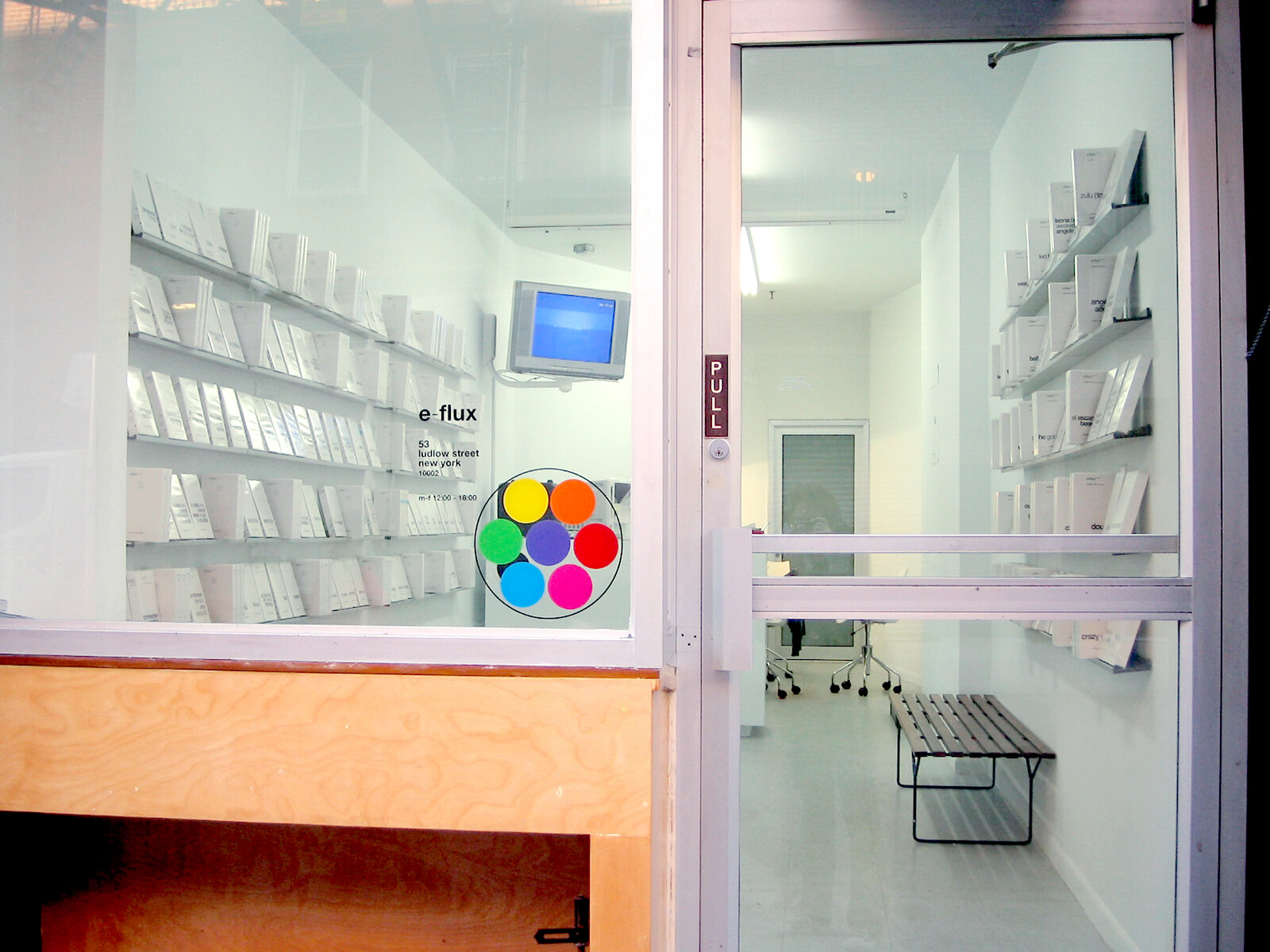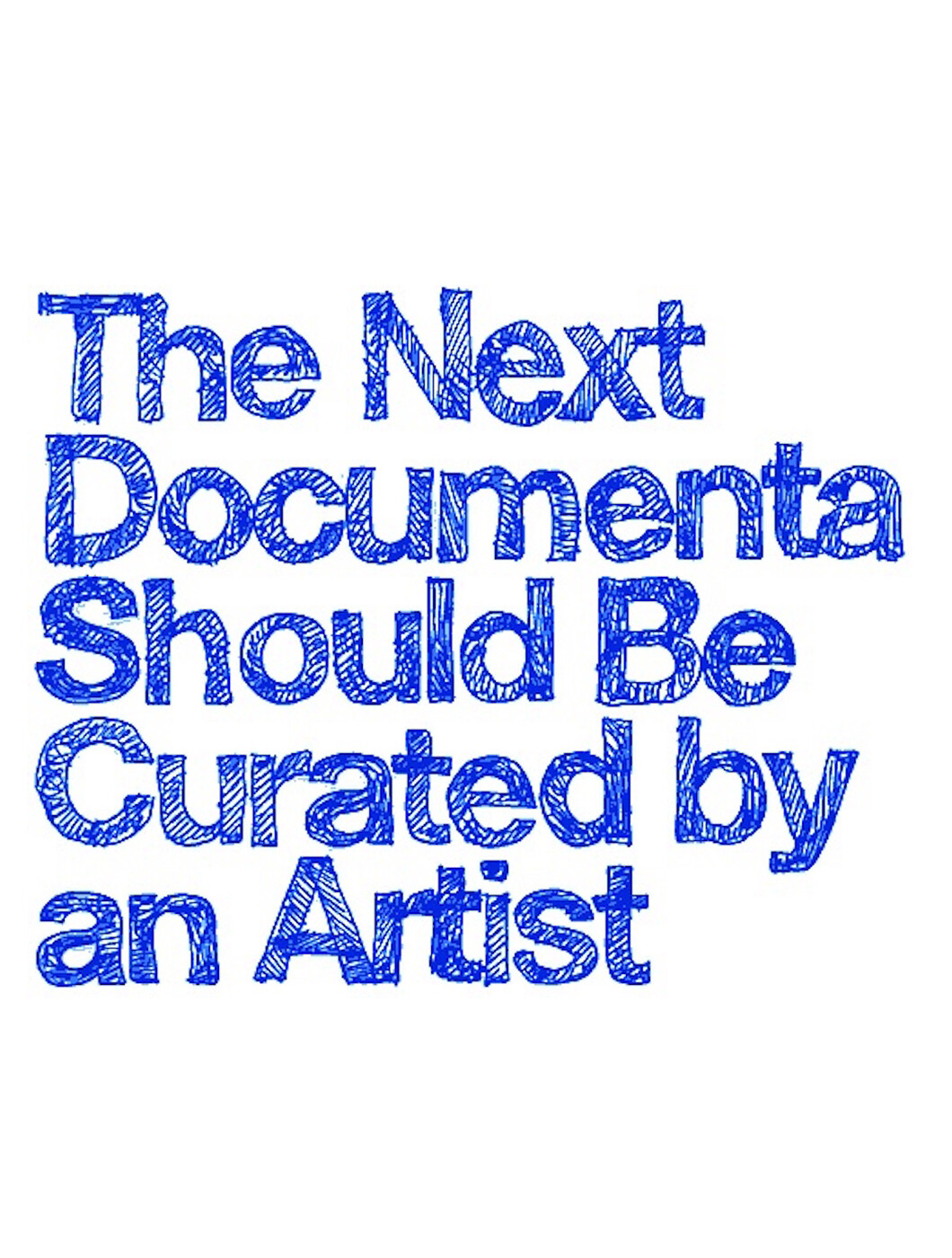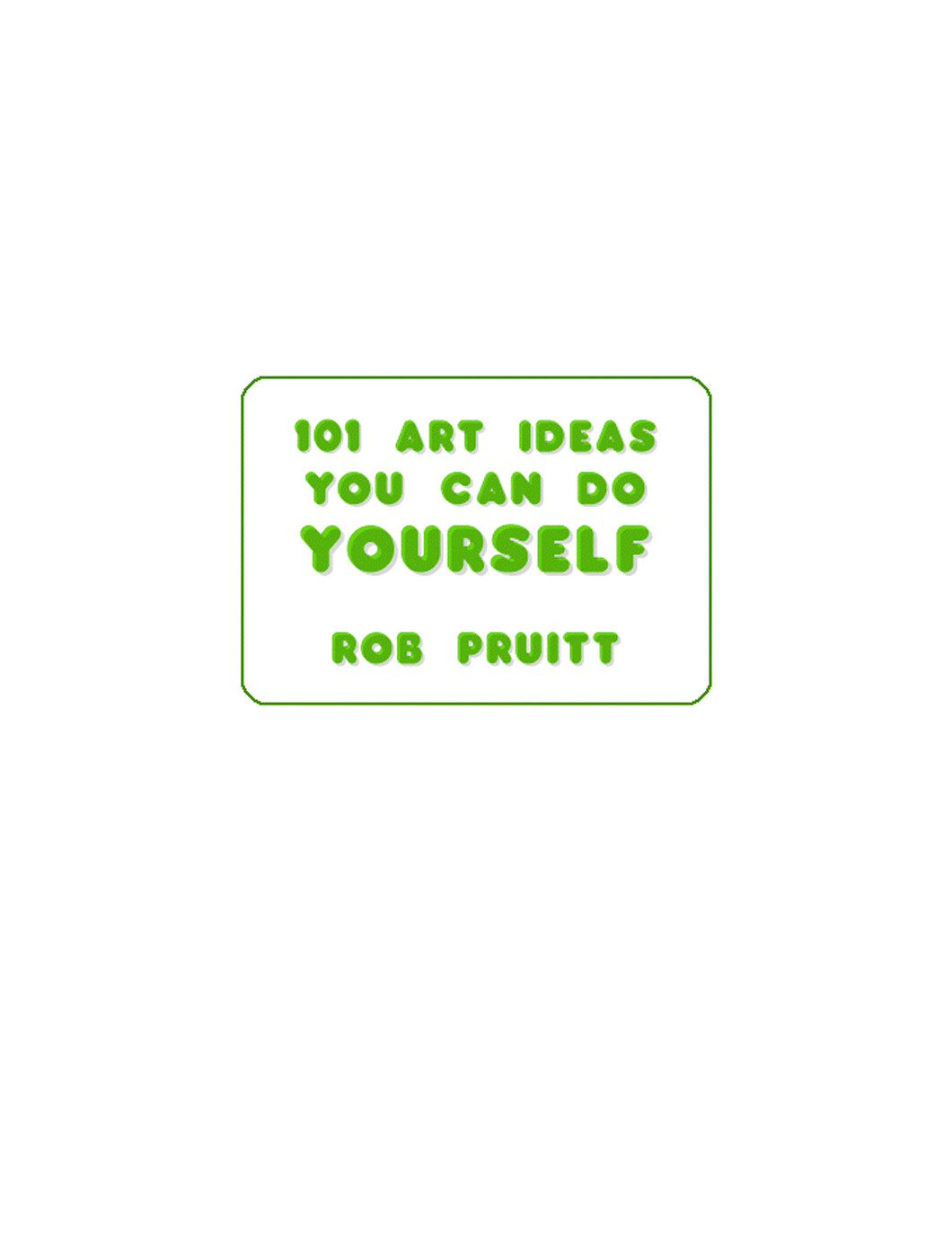Utopia Station
Utopia Station: posters by more than 100 artists. View them online, download the PDF and print them out. A 2003 Venice Biennal project, curated by Molly Nesbit, Rirkrit Tiravanija and Hans Ulrich Obrist.
What is a Station?
During a debate with Theodor Adorno in 1964, Ernst Bloch, pushed to the wall to defend his position on utopia, stood firm. Adorno had begun things by reminding everyone present that certain utopian dreams had actually been fulfilled, that there was now television, the possibility of travelling to other planets and moving faster than sound. And yet these dreams had come shrouded, minds set in traction by a relentless positivism and then their own boredom. “One could perhaps say in general,” he noted, “that the fulfillment of utopia consists largely only in a repetition of the continually same ‘today.’”
Bloch countered. The word utopia had indeed been discredited, he noted, but utopian thinking had not. He pointed to other levels of mind, to removes that were less structured by Western capital. Utopia was passing less auspiciously under other names now , he remarked, for example, “science fiction” and the beginnings of sentences starting with “If only it were so…”
Adorno agreed with him there and went on. “Whatever utopia is,” he said, “whatever can be imagined as utopia, this is the transformation of the totality. And the imagination of such a transformation of the totality is basically very different in all the so-called utopian accomplishments –which, incidentally, are all really like you say: very modest, very narrow. It seems to me that what people have lost subjectively in regard to consciousness is very simply the capability to imagine the totality as something that could be completely different.” How to think utopia then? Adorno saw the only possibility to reside in the notion of an unfettered life freed from death. All at once the discussion of utopia expanded; it became not merely old, but ancient. It seemed to shed ideologies as if they were skins. Adorno declared that there could be no picture of utopia cast in a positive manner, there could be no positive picture of it at all, nor could any picture be complete. He went very far. Bloch only followed him part way. He summoned up a sentence from Brecht . He let it stand as the nutshell that held the incentive for utopia. Brecht had written “Something’s missing.”
“What is this ‘something’?” Bloch asked. “If it is not allowed to be cast in a picture, then I shall portray it as in the process of being. But one should not be allowed to eliminate it as if it really did not exist so that one could say the following about it: ‘It’s about the sausage.’ … I believe utopia cannot be removed from the world in spite of everything, and even the technological, which must definitely emerge and will be in the great realm of the utopian, will form only small sectors. That is a geometrical picture, which does not have any place here, but another picture can be found in the old peasant saying, there is no dance before the meal. People must first fill their stomachs, and then they can dance.”
“Something is Missing,” the statement from Brecht. Typically when searching for utopia, one relies on the steps taken by others, for ever since its first formulation in 1516 in the book by Sir Thomas More, ever since its invention as the island of good social order, utopia has been a proposition to be debated, several speakers often pitching in at once. They bring thoughts, experience, the fruits of the past. For utopia is in many ways an ancient search for happiness, for freedom, for paradise. Sir Thomas More had had Plato’s Republic in mind as he wrote. By now however utopia itself has lost its much of its fire. The work done in the name of utopia has soured the concept, left it strangled by internal, seemingly fixed perspectives, the skeletons of old efforts which leave their bones on the surface of the body as if they belonged there. Has utopia been strung up? Or obscured by bad eyesight? Certainly it has gone missing. Utopia itself has become a conceptual no-place, empty rhetoric at best, more often than not an exotic vacation, the desert pleasure island of cliché. Abbas Kiarostami, when asked recently if he had any unrealized or utopian projects, refused the long perspectives of utopia altogether. He preferred to fix matters in the present, taking each day one hill at a time. We in turn have set our sights on the middle ground between the island and the hill. We will build a Station there and name it Utopia Station.
The Utopia Station is a way-station. As a conceptual structure it is flexible; the particular Station planned for the Venice Biennale is physical too. It will rise as a set of contributions by more than sixty artists and architects, writers and performers, the ensemble being coordinated into a flexible plan by Rirkrit Tiravanija and Liam Gillick. It has been important to all concerned that the plan not present itself as a finished picture. Let us therefore conjure up the Station by means of a few figures. It begins with a long low platform, part dance-floor, part stage, part quai. Along one side of this platform is a row of large circular benches sit, so that you can watch the movement on the platform or silently turn your back or treat the circle as a generous conversation pit. Each seats ten people. The circular benches are portable; as an option one could line them up like a row of big wheels. Along the other side of the platform a long wall with many doors rises up. Some of the doors take you to the other side of the wall. Some open into small rooms in which you will see installations and projections. The wall wraps around the rooms and binds the ensemble into a long irregular structure. Over it floats a roof suspended on cables from the ceiling of the cavernous room in the old warehouse at the far end of the Arsenale where the Station sits. Outside the warehouse lies a rough garden. Work from the Station will spill into it.
The Station itself will be filled with objects, part-objects, paintings, images, screens. Around them a variety of benches, tables and small structures take their place. It will be possible to bathe in the Station and powder one’s nose. The Station in other words becomes a place to stop, to contemplate, to listen and see, to rest and refresh, to talk and exchange. For it will be completed by the presence of people and a program of events. Performances, concerts, lectures, readings, film programs, parties, the events will multiply. They define the Station as much as its solid objects do. But all kinds of things will continue to be added to the Station over the course of the summer and fall. People will leave things behind, take some things with them, come back or never return again. There will always be people who want to leave too much and others who don’t know what to leave behind or what to say. These are the challenges for a Utopia Station being set up in the heart of an art exhibition. But in addition, there are the unpredictable effects, which Carsten Höller has been anticipating, the points where something missing turns to something that becomes too much. The doubt produced between these two somethings is just as meaningful as any idea of utopia, he believes. These tensions will be welcomed like a guest.
What does a Station produce? What might a Station produce in real time? In this produce lies an activity rather more complex than pure exhibition, for it contains many cycles of use, a mixing of use. It incorporates aesthetic material, aesthetic matters too, into another economy which does not regard art as fatally separate.
But what is its place? The discussion of this question has been opened again by Jacques Rancière, in his book Le partage du sensible, which in French has the advantage of having a partition and a sharing occupy the same word. What is sectioned off and exchanged? It is more than an idea. Rancière takes his departure from Plato, pointedly, in order to remind us of the inevitable relation between the arts and the rest of social activity, the inevitable relations, it should be said, that together distribute value and give hierarchy, that govern, that both materially and conceptually establish their politics. This theatre of relations wraps itself around visions of worlds, each of them islands, each of them forms, but all of them concrete realities replete with matter and force. This is a philosophical understanding of aesthetic activity; it extends materialist aesthetics into the conditions of our present; it is a book to bring to a Station. As we have. But, once released, a book too leaves its island.
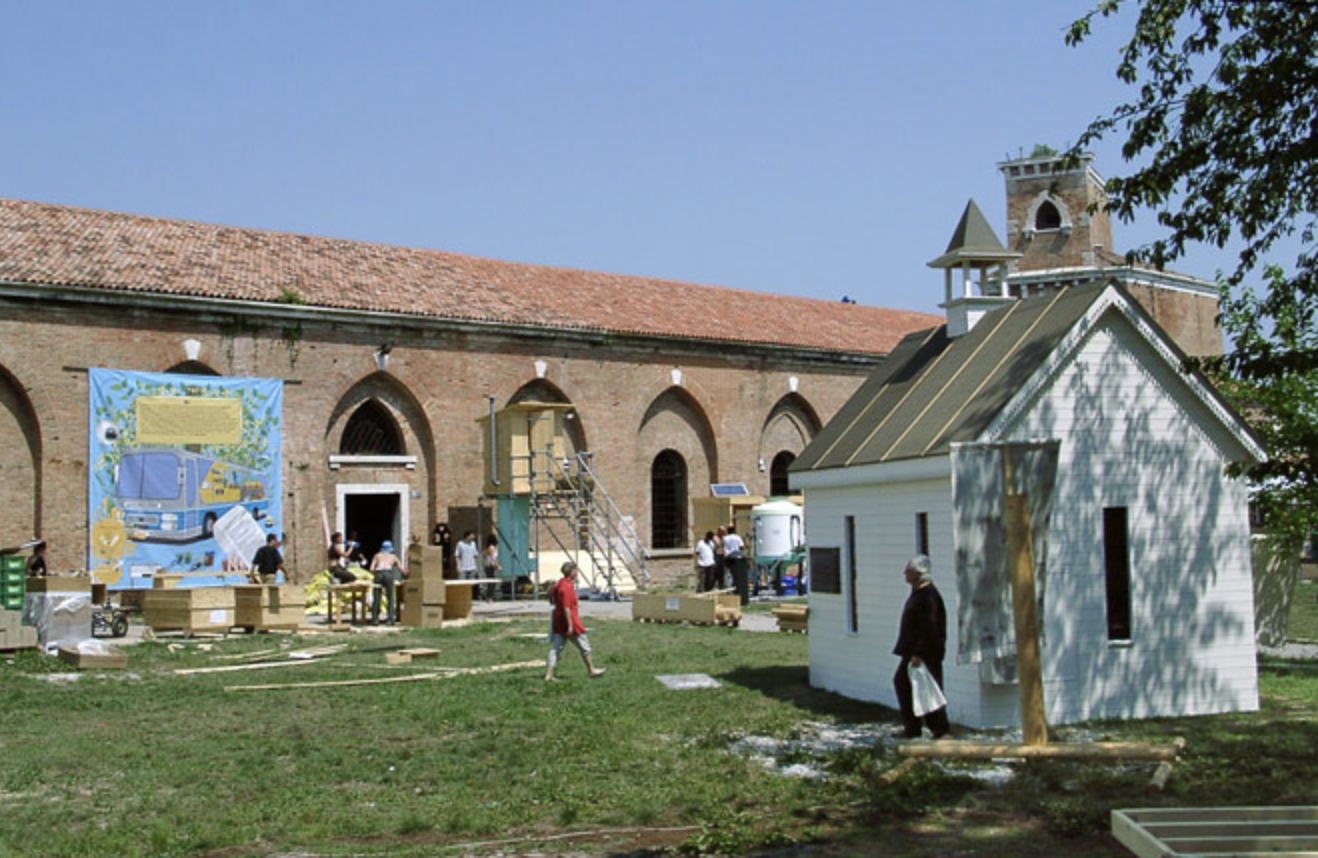
Utopia Station at the 50th Venice Biennale, 2003. Pictured in the photo is the chapel of The Church of Fear, initiated by Christoph Schlingensief. Image source: universes.art

Oleanna Space/Ship/Station, 2003, initiated by Martha Rosler together with the Oleanna Group, Yale group, Kirstin Dufour and Finn Thybo Andersen, Artists Against the War, Matteo Ballarin, and architect Andrew Herscher. Image source: martharosler.net

Church of Fear, 2003, a seven-day performance at the entrance of the Giardini initiated by Christoph Schlingensief. Image source: schligensief.com
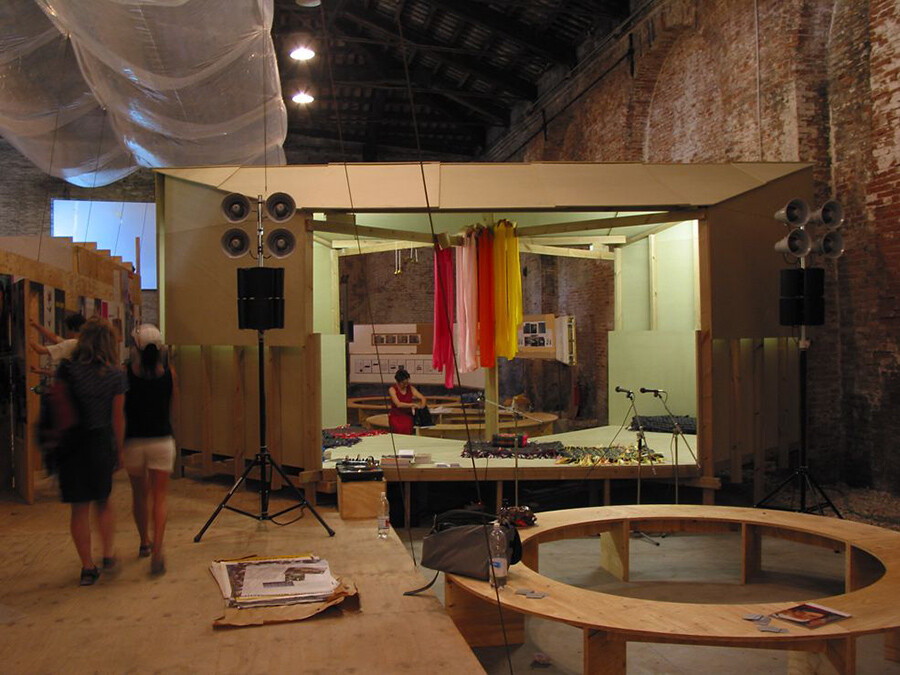
Uglycute, installation view of Sonic house at Utopia Station, 50th Venice Biennale, Venice, 2003. Image source: uglycute.com

Meeting around Love difference table initiated by Michelangelo Pistoletto for Utopia Station, 50th Venice Biennale, Venice, 2003. Image source: lovedifference.org

Leon Golub, installation view at Utopia Station, Haus der Kunst, Munich, 2004. Photo: Molly Nesbit.
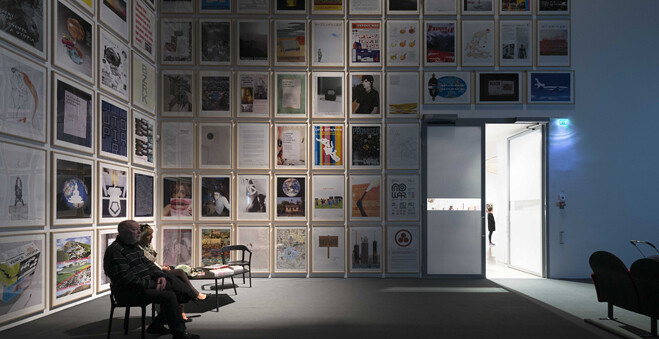
Exhibition view: Utopia Station, Moderna Museet Malmö © Photo: Åsa Lundén/Moderna Museet.
Utopia Station at the 50th Venice Biennale, 2003. Pictured in the photo is the chapel of The Church of Fear, initiated by Christoph Schlingensief. Image source: universes.art
The Utopia Station in Venice, the city of islands, is part of a larger project. Utopia Stations do not require architecture for their existence, only a meeting, a gathering. We have already had several in Paris, in Venice, in Frankfurt, in Poughkeepsie, in Berlin. As such the Stations can be large or small. There is no hierarchy of importance between the gatherings, meetings, seminars, exhibitions and books; all of them become equally good ways of working. There is no desire to formalize the Stations into an institution of any kind. For now we meet. Many ideas about utopia circulate. Once when we met with Jacques Rancière, it was in Paris last June, he spoke to the difficulties involved in putting the idea of utopia forward. He pointed to the line that says “There must be utopia,” meaning that there must not only be calculations but an elevation, a supplement rising in the soul, and said that this line of thought has never interested him. Indeed he has always found it unnerving, even irritating. That which does interest him, he explained, is the dissensus, the manner in which ruptures are concretely created—ruptures in speech, in perception, in sensibility. He turned to contemplate the means by which utopias can be used to produce these ruptures. Will it begin and end in talk?
On another occasion, in Poughkeepsie last winter, just as a blizzard was about to blow in, Lawrence Weiner reminded everyone present that the artist’s reality is no different from any other reality. Liam Gillick asked that we avoid utopian mirage, instead asking for utopia to become a functional step moving beyond itself. Martha Rosler told the story of going to see the space in Venice, arriving however as night fell to see only an interior of darkness, there being no lights. But utopia, she said, is what moves. Jonas Mekas warned of obsessions with ideas, since the dream, he said, could only succeed if we forget them. Leon Golub was apocalyptic. Allan Sekula, at our urging, showed the first five minutes of the tape he had made the day before during the peace demonstration in New York. Anri Sala showed us a tape of Tirana, where the mayor had painted apartment block walls into a geometric vision, a concrete hope. Edouard Glissant came. He spoke of the desire for the perfect shape, he spoke his language of landscapaes. Only by passing through the inextricable of the world, he told us, can we save our imaginaire. In that passing there would come the tremblement, the tremor being fundamental to the passage.
Nancy Spero sent a morphine dream. Agnes Varda sent us the song of the Cadet Rousselle. Together we read an article Etienne Balibar had written six years ago for Le Monde which proposed to take complete leave of utopia now, in order to return to the heart of the matter—to let the imagination free to accept the sudden emergence of subjectivity in the social field. Let us make a sudden rush, a place for the imagination to expand, a place of fiction, fiction in its fullest sense. Balibar sees fiction to be the production of the real, something stemming from experience itself, knowledge and action brought together so that they become indistinguishable, insurrection emptying into constitution. He used the thoughts to preface his Droit de cité. Another book for the Station.
It is simple. We use utopia as a catalyst, a concept most useful as fuel. We leave the complete definition of utopia to others. We meet to pool our efforts, motivated by a need to change the landscape outside and inside, a need to think, a need to integrate the work of the artist, the intellectual and manual laborers that we are into a larger kind of community, another kind of economy, a bigger conversation, another state of being. You could call this need a hunger.
Dare one rewrite a sentence by Brecht? Something we need is missing. Theman who, seventy years ago, wrote “Art follows reality” would surely not mind. Let us then take these words and press on. We need the words, old words and new words, we need the dance, we need the sausage, and still we need more. We have started, we meet in the Utopia Station, we start out again. The Station becomes a place to gather our starting points temporarily. It is primarily for this reason it resists capture and summary as a single image. Or is it the image of open possibility? The image of mixed use? Many things will happen there. And they will spark others.
Think of the Station as a field of starting points, many starting points being brought and offered by many different people. Some will bring objects now, others later. Each present and future contributor to the Station is being asked to do a poster for use in the Station and beyond: wherever it can hang, it can go. A paper trail for once goes forward. New posters continue to be added. In this way the Utopia Station produces images, even as it does not start with one. And a loose community assembles. It develops its own internal points of coherence, which shift with the times, as conversations and debates do.
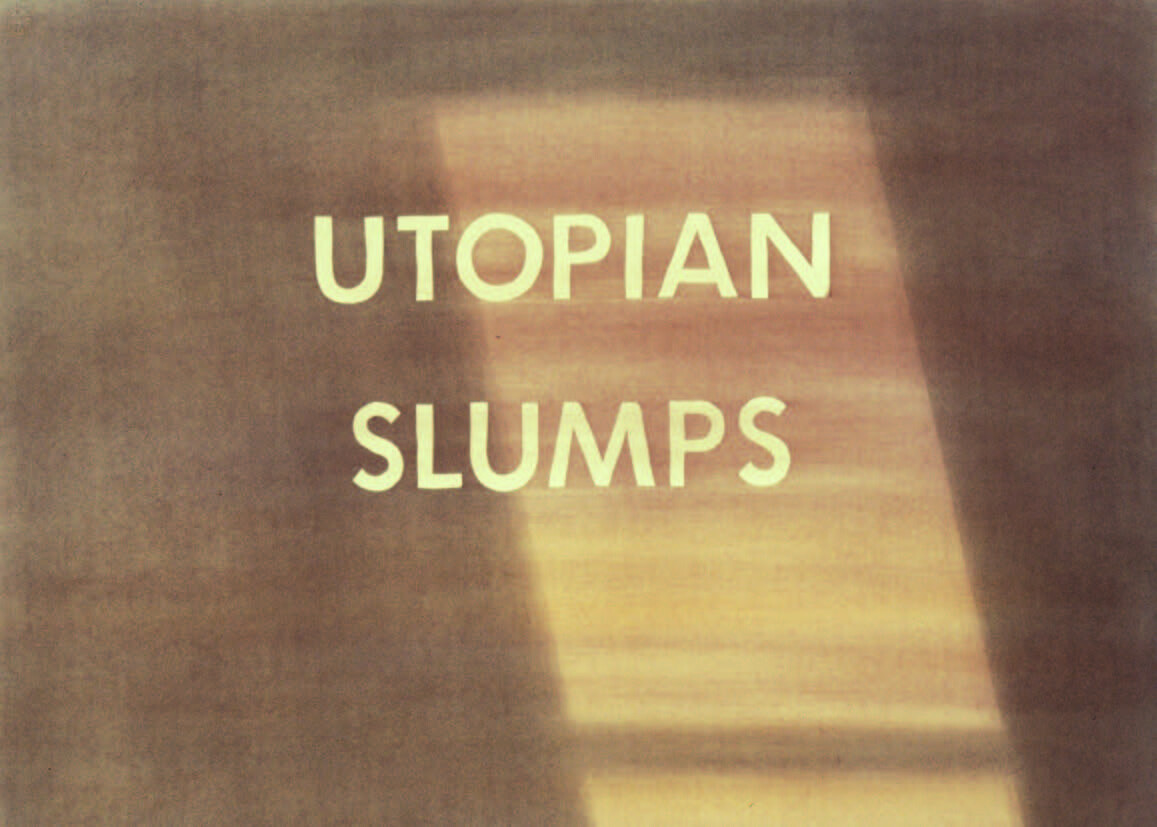
Ed Ruscha for Utopia Station, 2003

Gustav Metzger for Utopia Station, 2003
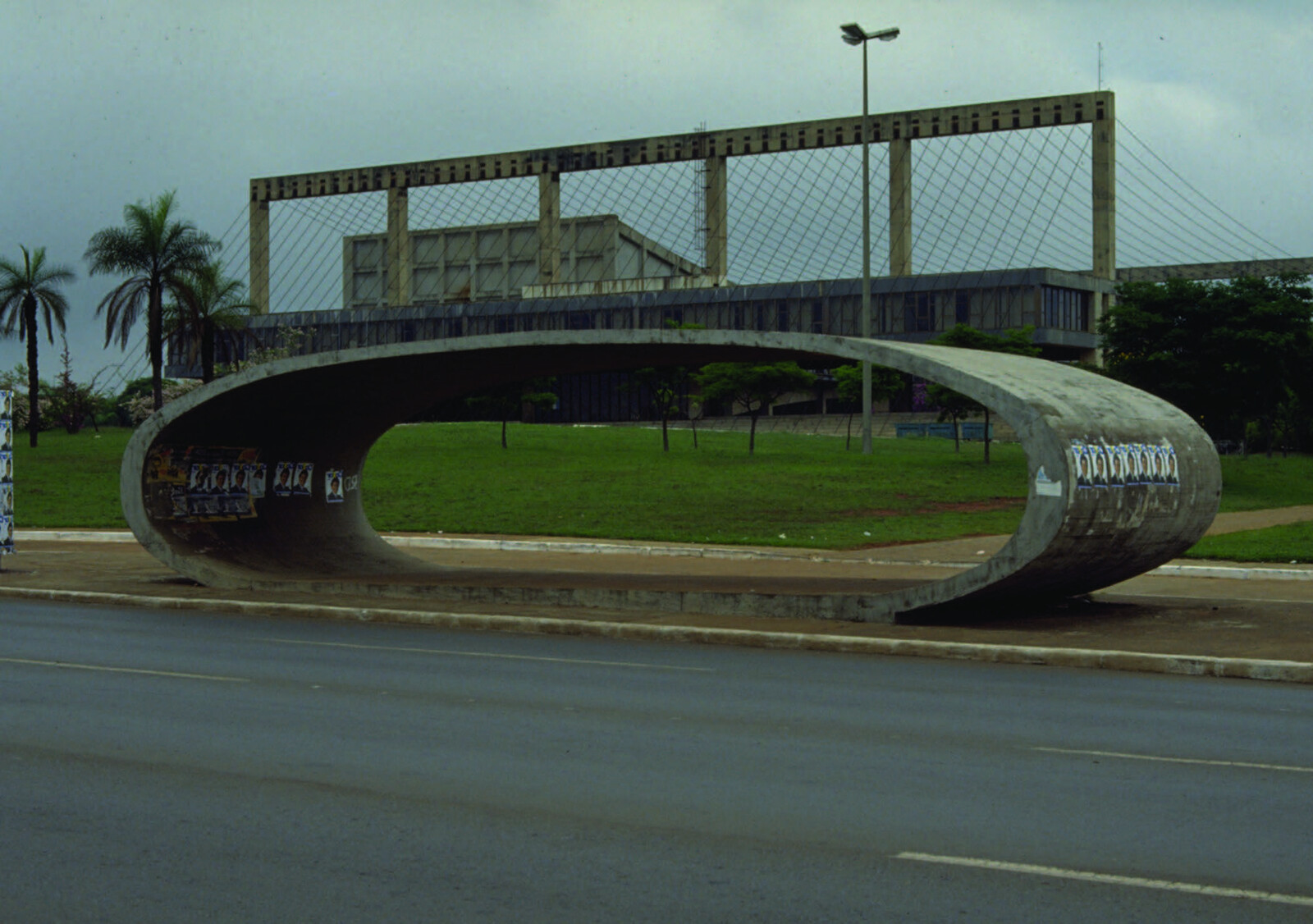
Peter Fischli and David Weiss for Utopia Station, 2003
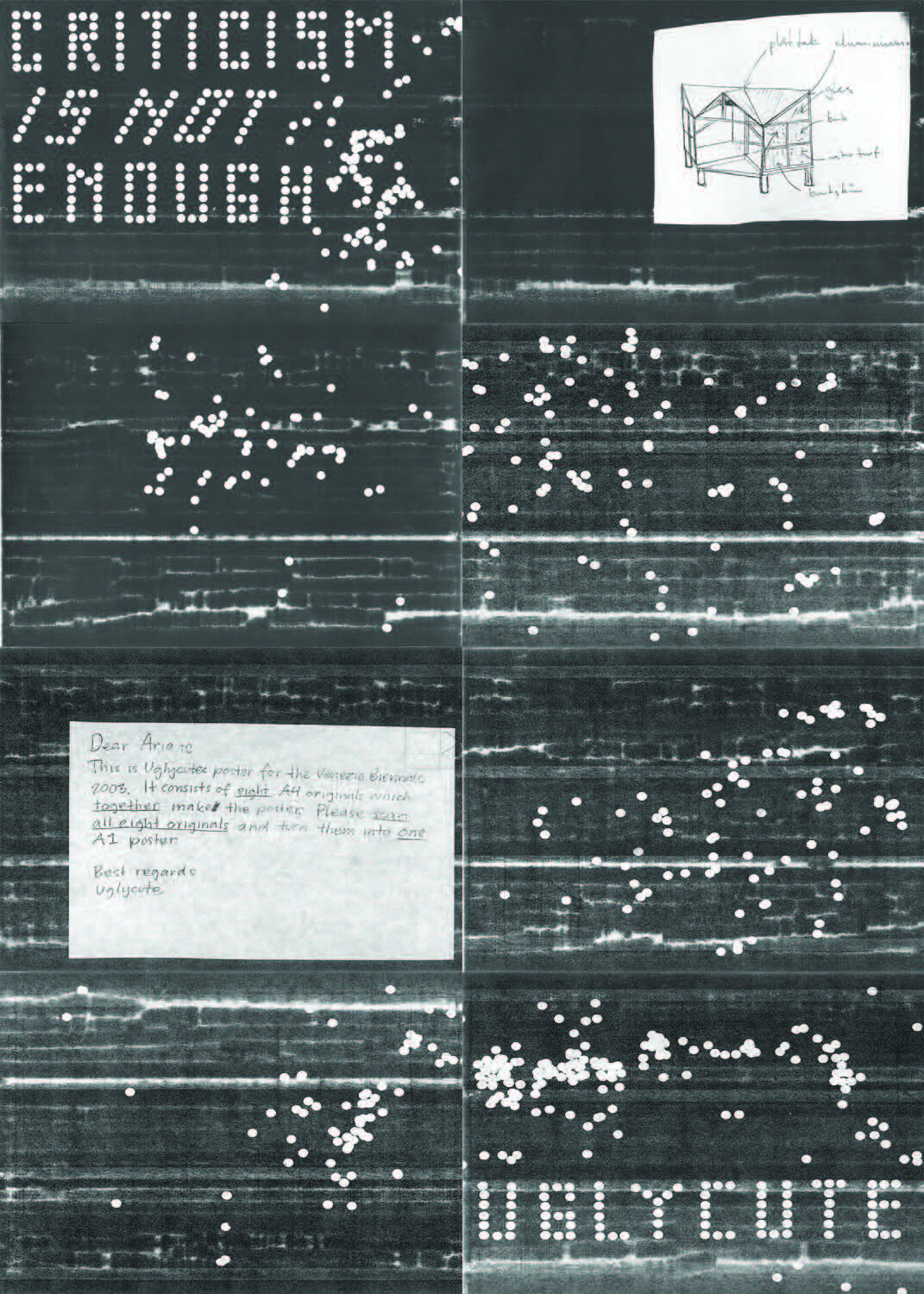
Uglycute for Utopia Station, 2003
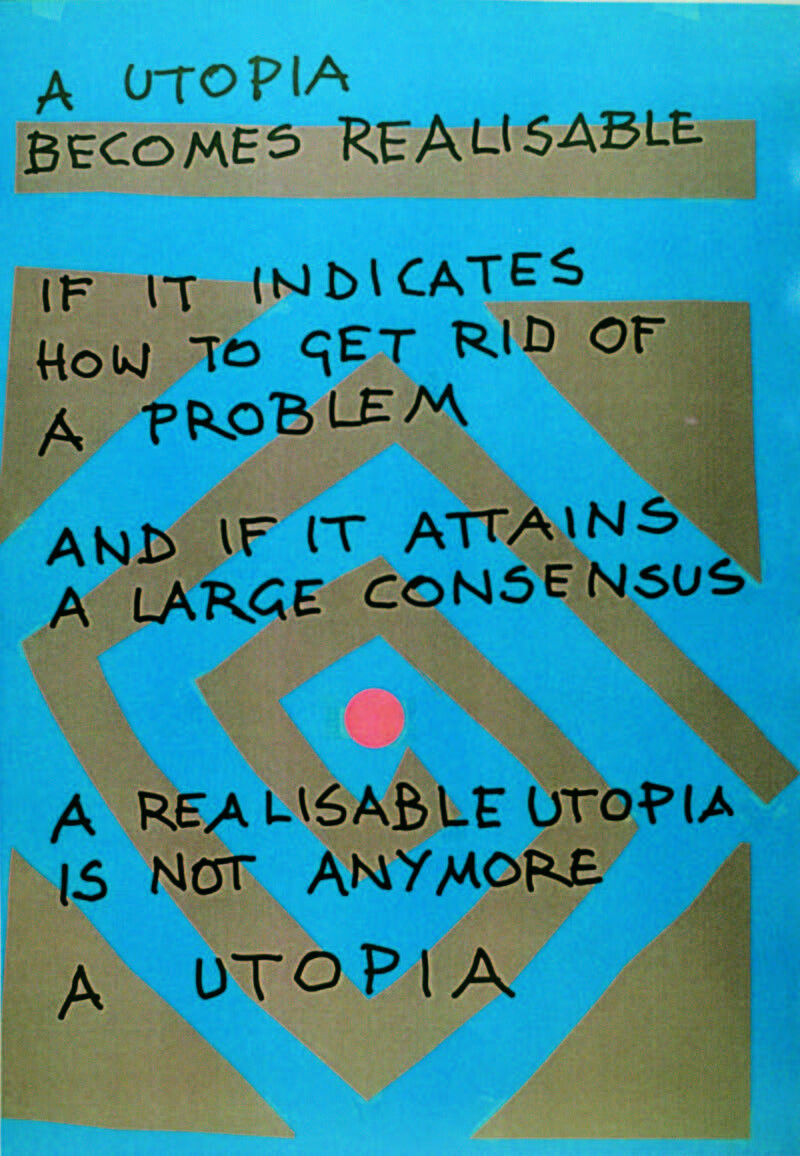
Yona Friedman for Utopia Station, 2003
Ed Ruscha for Utopia Station, 2003
Each person making a poster has been asked to make a statement of at least one and up to two hundred words. Independent of one another the statements collect. Stuart Hall and Zeigam Azizov elaborate upon a proposition: the world has to be made to mean. The bittersweet baked into hope, writes Nancy Spero. Pash Buzari sent a poem where darkness is dialed. Raqs Media Collective calls utopia a hearing aid. This probably will not work, Jimmie Durham cites the Cherokee, and adds that the “probably” keeps people active. There will be hundreds of statements like these in the end. They will branch out. As they do certain figures begin to repeat. Ships and songs and flags, two times potatoes, two times Sisyphus, figures familiar from the discussion of utopia forty years ago, but they have been assimilated rather than cited. Utopia becomes the secret garden whose doors can be opened again. Utopia becomes the catalyst that burns and returns. None of us can say we begin from scratch.
These actitivities imply an activism. For many who come to the Station, its invitation to self-organize speaks a political language already known to them and already being practiced. The proposal to build non-profit de-centralized units and make them become the underlying mode of production, fitting together through the real market (not the monopolistically controlled world market of the present system), has been made by Immanuel Wallerstein in his book Utopistics. It would eliminate the priority given to the endless accumulation of capital. Still another book for the Station.
As the catalyst burns, it fumes. For ours is not a time of continually same todays. When we met in Poughkeepsie in mid-February, around the world vast crowds marched for peace. Seven weeks later, when we met in Frankfurt, the Coalition forces were entering Baghdad. The days come like Kiarostami’s hills. It is not the continually same utopia. In the speech to the graduating West Point cadets in June 2002, President George Bush announced his policy of pre-emptive strikes and wars with the reassurance that “America has no empire to extend or utopia to establish.” The idea of empire has been receiving much scrutiny. But what about the other idea here, the refusal of utopia, the concept that presumes forward social vision? Is it not this refusal that gives us reason enough to revive the question of utopia now? Whether it comes as catalyst or fume, the word should be pronounced. And so we start.
Molly Nesbit
Hans Ulrich Obrist
Rirkrit Tiravanija
Reviews
“PICTURES OF AN EXHIBITION: THE 50TH VENICE BIENNALE” •
Francesco Bonami’s 50th edition of the Venice Biennale—”Dreams and Conflicts: The Dictatorship of the Viewer”—delegated responsibility to nearly a dozen curators and, ultimately, to the viewers themselves, pointedly bringing an end to the monolithic “Grand Show” of yesteryear, for better or (as the consensus seemingly would have it) for worse. And the…
Francesco Bonami’s 50th edition of the Venice Biennale—”Dreams and Conflicts: The Dictatorship of the Viewer”—delegated responsibility to nearly a dozen curators and, ultimately, to the viewers themselves, pointedly bringing an end to the monolithic “Grand Show” of yesteryear, for better or (as the consensus seemingly would have it) for worse. And the unseasonable weather didn’t help. At June’s heat wave–plagued vernissage, many openly wondered whether it was the lack of inspiration or rather the perspiration that was dampening their enthusiasm. We invited three regular contributors—art historian LINDA NOCHLIN, Artforum editor-elect TIM GRIFFIN, and scholar-critic SCOTT ROTHKOPF—to assess the exhibition, after the heat of the moment.
IN THE BAG
Scott Rothkopf
Of the nearly four hundred artists in this year’s Venice Biennale, one handily seized the spotlight at the vernissage with little help from the curators and almost no effort of his own. While his official entries hung discreetly in the Museo Correr, his work swept across the canals by vaporetto and water taxi, alighted on the breakfast tables of the Gritti Palace, and dangled from the arms of art aficionados making their way through the chaos of the Arsenale. Takashi Murakami was everywhere. For two hundred fifty euros or “your best offer,” an African street vendor would sell you a fake Louis Vuitton bag emblazoned with the artist’s splashy take on the venerable LV monogram; for several hundred euros more, you could score the real thing at the local Vuitton boutique; or for the price of admission to the exhibition, you could ogle his paintings—all within a few hundred square feet. Just as Murakami’s bags and their knockoffs cropped up everywhere from Canal Street to Oprah last spring, they spread through Venice like a virus, but against the pious backdrop of the 50th Biennale, his logomania suddenly looked seditious as never before.
If Murakami’s satchels seemed at all subversive in Venice, it was certainly not because they demonstrated the obviously critical—or, at the very least, ironic—relationship to the global culture industry that was de rigueur at the Biennale. The staggering ubiquity of his bags in the Giardini had almost nothing to do with the calculated “disturbances” of Conceptual artists who since the 1960s have bought advertising space in mass media outlets, or with the legions of photographers who have more recently churned out glossy fashion pages and glossier Cibachromes. This was clearly not a case of market infiltration, but rather penetration, which surpassed even Warhol’s guest spot on The Love Boat and was perfectly suited to an omnivorous oeuvre that engages questions of copyright and consumption with ruthless glee. Yet within the context of Francesco Bonami’s sprawling Biennale, the bags seemed like an outright provocation—not against the stranglehold of international market forces but against Bonami’s self-proclaimed curatorial premise, targeted as it was against the very “breaking wave of globalization” that Murakami’s bags seemed so effortlessly to ride.
In his introductory catalogue essay, Bonami frames this year’s Biennale as nothing less than an attempt to “conceive of a new exhibition structure” for the “Grand Show.” He defines his approach in direct opposition to that of the Biennale’s previous director, Harald Szeemann, and a lineage of “monolithic” mega-exhibitions that since the 1960s have dominated the international art scene and, increasingly, its audience. In the name of a liberating and “more intimate” viewing experience, Bonami delegated curatorial responsibility to eleven colleagues, who along with him have organized a total of eleven official shows, as well as a series of “Links” and “Interludes,” all of which vie for attention with the national pavilions. While Bonami was wise to question how the “Grand Show” has come to posit an elusive viewer with endless amounts of time—to say nothing of patience—his solution only exacerbates the problem.
Making one’s way through the seemingly endless Arsenale, it was hard to see how a welter of exhibitions was any more sensitive to art and its audience than a single focused show might have been. There one encountered a series of intentionally dissonant presentations, several of which were organized in classic World’s Fair style by continent or region. One trekked from Africa and its diaspora, on to Asia, and finally to the Arab world, each stop brimming with enough information-laden art to fuel a high school social studies curriculum. The best of the bunch, Carlos Basualdo’s “The Structure of Survival,” focuses primarily on Latin America, but within a broader geographic and generational framework, which accommodates contributions by senior figures, including Gego and Hélio Oiticica, alongside fresh efforts, such as an impressive installation by Rachel Harrison. Still, if Bonami truly hoped to eschew traditional power structures, it seems puzzling that he has parceled out so much of the Biennale according to such conventional borders—a particularly troubling arrangement in that it individually quarantines the art of non-Western cultures in the name of a broader global perspective. Bonami’s disavowal of a synthetic presentation seems to rest on the mistaken assumption that a focused curatorial argument is, as he has written, necessarily “hegemonic” or leveling of art’s true diversity. Nowhere is this abdication of curatorial responsibility more painfully clear than in his own obscure show “Clandestine,” the concept of which is as hidden as its title suggests. Here Okwui Enwezor’s recent Documenta serves as an instructive counterexample, insofar as that exhibition suggested a cogent, if somewhat overstated, curatorial viewpoint, which rather than stifling the artworks generated meaningful connections among them.
For Bonami, the Biennale’s fractured structure is not simply an answer to the problem of the “Grand Show,” but more important, it serves as a response to the shadowy threat of globalization, the “waning of individuality and uniqueness.” In his catalogue essay, he proposes a “new reality somewhere between Globality and Romanticism, where economics and information finally intersect within the complexity of an individual’s identity and emotions … a world where the conflicts of globalization are met by the romantic dreams of a new modernity.” He has christened this spirit “Glomanticism” (a term that’s in and of itself an affront to the culture industry, because it surely would never have survived a marketing focus group). In three of Bonami’s own shows one found the “glomantic” spirit represented in a wide assortment of works by Matthew Barney, David Hammons, Franz Ackermann, Peter Doig, and Magnus von Plessen, among many others. It would be easy to characterize “Glomanticism” as a regressive conceit, and theoretically minded critics have long condemned similar retreats into the psyche of the expressive, authorial subject (Craig Owens’s 1982 attack on the Romanticism of Documenta 7 comes to mind). But the problem with Bonami’s “Glomantic” model is not its defense of a spiritual interiority per se so much as the curator’s somewhat disingenuous characterization of this approach as a viable form of political resistance. Such questionable claims are familiar from the early days of Abstract Expressionism but become especially hard to swallow in the context of exhibition literature liberally peppered with corporate sponsorship logos. Still, there’s a kind of poignant desperation to Bonami’s stance, and it’s indicative of an art world haunted by its impotent relationship to recent geopolitics yet understandably anxious to frame art as a socially redemptive practice.
This desire was most palpable at “Utopia Station,” where cocurators Molly Nesbit, Hans-Ulrich Obrist, and Rirkrit Tiravanija served up a rabbit warren of spaces crammed with work by an impressive army of artists. Visitors could take in numerous videos, catch a performance organized by Martha Rosler and a cohort of art students, or sample enough panel conversations to raise the spirit of Joseph Beuys’s “social sculpture” from the dead. In their accompanying catalogue essay, the curators explain this confusing cornucopia as an attempt to reconsider utopia and to incorporate “aesthetic material, aesthetic matters, too, into another economy which does not regard art as fatally separate.” But what could have been more “fatally separate” than a cloistered space at the end of a kilometer-long Venetian Arsenale, accessible only to the most devoted pilgrims? There art’s incorporation into “another economy” was apparently evidenced by Atelier van Lieshout’s rough-hewn (and soon inoperable) outhouse, or by the visitor’s choice between an artist-imported, eco-friendly cola and an acqua frizzante from the snack bar. Perhaps it was fitting that a kind of playacting reverie enveloped the Station; or that it appeared somehow more meaningful to its actors than its audience; or even that its stated goal was simply to promote discussion, as had already been done at far-flung preliminary symposia from Frankfurt to Poughkeepsie. Yet despite several admirable contributions and an appealing air of optimism, the overall presentation suggested a sort of troubling solipsism couched as activism, an insider’s conversation in the guise of global outreach and engagement. This feeling was hardly mitigated by an installation of such dizzying opacity that most visitors seemed less interested in the art and ideas than in the chic souvenir totes branded with the Station’s logo and that of fashion designer Agnès B.
In Venice, the legacy of the ’60s was of course present in more than just utopian visions, as curators and artists alike found fresh impetus to wrestle with that decade’s weighty inheritance. While many attempts to negotiate the past appeared embarrassingly revivalist, Felix Gmelin offered a subtle meditation on the correspondences and ruptures between activist strategies then and now. In the Italian pavilion he presented Farbtest, Die Rote Fahne II (Color test, the red flag II), 2002, a pair of videos projected side by side on a wall. The left projection shows footage of a demonstration in the form of a relay race, with a series of men passing off a large red flag as they run down a Berlin street directly toward a perpetually retreating camera. The action, involving Gmelin’s father, took place in 1968 and ended with the raising of the flag on the balcony of city hall, the site of President Kennedy’s famous 1962 address. The right projection shows the same action restaged a generation later—in Stockholm in 2002, several months after the anti-globalization rallies in Genoa and Göteborg, Sweden. Gmelin timed the second race to match the first so that we see the flags handed off on each monitor almost exactly in sync. Tinged with nostalgia, but not naively so, Farbtest questions the efficacy of appropriated political strategies. Can activism be meaningfully transposed from one place and time to another? In what ways is the “color test” alluded to in the work’s title a formal statement as much as a political one? Gmelin leaves these questions unanswered, but it is their concise and elegant formulation that made one want to ponder them more than many of the overblown statements elsewhere on display.
Though arguably more market friendly, Chris Ofili’s paintings offered an alternative model for addressing broad social concerns within a compelling personal idiom. At the British pavilion, the painter presented a suite of densely layered canvases and delicate gouaches, starring a pair of Afro-capped lovers in a hothouse effulgence of glitter and palm fronds, halfway between the Copacabana and Paradise. The smartly dressed duo call to mind Ike and Tina as readily as Adam and Eve, and it is precisely this exuberant mix of allusions that lends Ofili’s paintings their evocative romanticism and hot-wired cultural charge. Apart from a dash of gold, each of the works in the show, as well as the pavilion itself, has been meticulously executed in only red, black, and green, a primary palette descended from Marcus Garvey’s 1920 Universal African flag by way of rap posters and pot paraphernalia. Unlike much of the finger-wagging art in Venice, Ofili’s paintings betray a keen sensitivity to the power and allure of pop-cultural myths from the dance hall to the barricades. While such an attitude may not be revolutionary enough for some, it represents a generous and lively take on a complex landscape of symbols both mundane and sublime.
A more bravado political gesture could be found nearby in Santiago Sierra’s installation at the Spanish pavilion. There Sierra covered the sign ordinarily announcing “Spagna” with a black plastic tarp and masking tape. Just twenty-six inches past the pavilion’s main entrance, he built a rough cinderblock wall spanning the width of the building, so that visitors were completely barred from passing farther than this messy liminal zone, strewn with the detritus of the wall’s construction and a now unenclosed toilet. After following a dusty path to the pavilion’s back door, one encountered two armed uniformed guards who informed visitors that entrance was permitted only upon presentation of a Spanish passport or other legal identification. While this ploy may have at first appeared gimmicky, the installation came alive after one witnessed scores of disgruntled non-Spanish visitors turned away at the door (one indignant Dutch couple put up a good fight to no avail). Sierra, more than any of the participating artists, seemed to understand the implications of a national pavilion as a quasi-sovereign space. Although this politicized zone was obviously staged, its implications were made forcefully real. Would-be visitors unexpectedly confronted the conflation of political and spatial barriers, an experience made all the more jarring and timely following the softening of borders within the EU, as well as their recent tightening in other parts of the world.
Across the Giardini, it was politics, or rather “business,” as usual for United States representative Fred Wilson. As part of his didactic exploration of the history of blacks in Venice, he hired an African immigrant to stand outside the US pavilion with a passel of artfully faked designer handbags. Unfortunately, however, they weren’t actually for sale, or at least not without a call to Wilson’s gallery. According to the Financial Times, the artist remarked that his museum-ready creations “will be for sale. Just not at the usual street prices.” For all those viewers who might have bemoaned Murakami’s troubling market complicity and the evils of globalization, here was a bag with more respectable credentials than even the totes at Utopia Station. Nestled safely within the outstretched wings of the American pavilion, the handbags (and their salesman) were clearly framed as “art,” not fashion, with all the requisite critical distance such a distinction implies. Yet the gesture seemed outright tame and contrived in light of the vendors outside the Giardini hawking “real” knockoffs, seductively plastered with counterfeit reinterpretations of a reinterpreted monogram. Murakami’s bags may indeed signal art’s ominous and orgiastic embrace of global consumption, but in contrast to the Biennale’s largely tired take on geopolitics, they somehow seemed less fake than true.
Scott Rothkopf is an art historian based in Cambridge, Massachusetts.
LESS THAN MORE
Linda Nochlin
What is utopia? How does the utopian idea engage with history as well as with the present? How might utopia be reconceived and reconfigured for our troubled times? And how can utopia—a concept typically set forth in a text—find its material counterpart in works of art? These and related questions are raised by “Utopia Station,” a heterogeneous, multiform, sometimes messy but always provocative, indoor and outdoor, large-scale exhibition of objects, installations, videos, films, and performances by sixty artists and collectives, curated by Molly Nesbit, Hans-Ulrich Obrist, and Rirkrit Tiravanija for the Venice Biennale.
“Utopia Station” is a literal “station”—last stop on the line of exhibitions on view at the Arsenale. But it is a station in a metaphoric sense, too: one arrested moment in an ongoing investigation that has included the Utopia Seminar (part of the graduate program in visual arts at the University of Venice), a weekend gathering in Poughkeepsie, New York, the publication of a journal, Janus, in Belgium, and an ambitious poster project including works by such well-known artists as Marina Abramovic, Fischli & Weiss, Leon Golub, Steve McQueen, Annette Messager, Elizabeth Peyton, Rosemarie Trockel, Thomas Hirschhorn, Louise Bourgeois, and Ed Ruscha. And given the near-hundred-degree heat in Venice, it was impossible, walking and rewalking the long, long trail to the show with bleeding feet and burning head, not to relate “station” to the physical suffering and mental anguish narrated in the stations of the cross. But once you got there, things changed. In the heat and agitation of the Biennale press opening, “Utopia Station” offered a kind of redemptive, if unkempt, respite. The station itself was planned as a long, low platform—part dance floor, part stage, and part quay, to paraphrase the curators. Along one side was a row of large circular benches and tables, designed by Liam Gillick, where one could read, talk, rest, powder one’s nose, or take off one’s shoes as the spirit moved. On the other side was a wall intersected by small rooms for installations, performances, and projections. Outside was a rough, weedy, but spacious garden planted with installations, events, seating space, and not quite enough shade.
Among the most memorable works on view at “Utopia Station,” indoors or out, were Agnès Varda’s video projection Patatutopia, 2003, which features close-ups of potatoes, their withered complexions creating a sense of uncanny pathos as they move and metamorphose across the screen; Yoko Ono’s contribution, which includes the “Declaration of Nutopia” signed by John Lennon and herself in 1973 and wall maps on which visitors are encouraged to stamp the words IMAGINE PEACE; an enchanting video by Shimabuku called When sky was sea, 2002, featuring fish kites floating in a sea-sky of heavenly blue; a series of album covers by Rodney Graham, done in the blackest of black inks; and Tacita Dean’s Alabaster Window Project, 2003, a stained-glass window in muted colors, suggesting, perhaps, transcendence.
Despite such highlights, I think it is fair to say that few of the works on view engage directly with the idea of utopia that inspired the show. In some cases, utopia might present itself through a sort of willed free association: For example, if you had seen Varda’s wonderful film Les Glaneurs et la glaneuse (2000), you might connect her potatoes to the theme of gleaning and the ecological ideal of living on leftovers, a utopian notion of sorts. But on the whole, the utopian idea was implicit rather than explicit, figurative rather than literal in the work on view in Venice—with rare but welcome exceptions.
There was, for example, Martha Rosler’s Speculations and Speculative Fictions, 2003, which, to borrow the words of its creator, was “an episodic investigation of time, time travel, and visions of social transformation,” performed in the setting of a still larger project, the Oleanna Space/Ship/Station, which drew on ongoing collaborations with present and former students from around the world. Engaging science-fiction literature, especially the 1970s feminist variety, this multipartite work considered the hazards of travel from the time of Homer to the era of the space shuttle. Some of the political inspiration for the piece came from a renegade Scandinavian branch of the Situationists who were expelled from the movement for refusing to renounce the art world, a nice utopian irony in the context of the Venice Biennale!
The work on view that grapples most directly perhaps with the historical idea of utopia is Leif Elggren and Carl Michael von Hausswolff’s portentously titled The Annexation of Utopia by the Kingdoms of Elgaland-Vargaland, 2003, a book-shredding and
-recycling act for which the Swedish artists pulped multiple copies of a specially printed edition of Sir Thomas More’s Utopia (1516), formed the pulp into lovely sheets of raw paper, and hung them out to dry on open-air clotheslines in an attractive triangular installation in which meaning is erased in favor of sheer materiality. Obviously, this was meant as an ecological sermon of sorts—returning printed matter to basic substance—but More’s Utopia, the earliest and best-known of all its namesakes, is well worth reading before it goes into the shredder.
Reading the book in bed that very night, on returning from the Station, I was amazed at the boldness of a sixteenth-century humanist who could invent such a dizzy ideal society, a no-place, presumably in the New World, where jewels and gold are demoted to the rank of children’s toys and men and women are more or less equal; where hunting and gambling, major pleasures of the aristocracy, are ruled sordid pastimes and forbidden and people are content to pass their leisure time in music making and reading; a community in which justice and equality are the political ideals and kindness and generosity a way of life. It became clear, reading More’s Utopia, that, like later utopian visions—Charles Fourier’s in France or William Morris’s in England—one of Utopia’s goals is to offer a stringent critique of contemporary society while also providing more satisfying alternatives to existing social arrangements. At “Utopia Station,” this critical aspect of the utopian project was perhaps best represented by the active presence of Rosler, who, in a wide range of media from video to installation to slide shows, has been criticizing American politics and gender disparities with wit and energy ever since the Vietnam War and the women’s movement of the ’70s.
One of the major problems confronting all utopian dreamer-planners, and addressed at the exhibition in a variety of forms, is, Who is going to do the dirty work in the ideal society? Who will take out the garbage, dig the cesspools, slaughter the animals (in non-vegetarian utopias like More’s, at any rate)? For More, the answer is slaves, deemed at the time to be nonpersons (rather like the robotic helpers in later techno-ideal societies) suited to spare the citizens of utopia firsthand bloodshed and cruelty. This started me thinking about Fourier’s solution to the problem of dirty work. To put it as succinctly as possible, this nineteenth-century utopian socialist’s goal was pleasure—all the time, for everybody. “We shall see people engaged in attractive occupations, giving no thoughts to material wants, free from all pecuniary cares and anxieties,” declares Fourier in “On Social Organization” (1820). “A unity of interests and views will arise, crime and violence disappear,” he continues. “Universal happiness and gaiety will reign.” To this end, sexual pleasure is organized on a stringently egalitarian basis: Squads of young men service older women; older men initiate young girls, and the young folks get their chance only after they have done their erotic duty for their elders. And Fourier’s solution to the dirty-work problem? “To secure the execution of uncleanly and offensive labors, a body of youths … shall perform them all. For the young love to wade in the mire and play in dirt, are self-willed, rude, daring, and fond of gross language,” asserts Fourier.
I go into such detail partly because I am seduced by the Fourierist utopian ideal and partly because one of the most inviting structures in the scraggly field of “Utopia Station” deals precisely with this perennial problem of waste disposal in the utopian community. I am referring to the Dutch collective Atelier van Lieshout’s scatopia, 2002, an ambitious contraption designed to recycle human waste. It includes—shades of Duchamp—a urinal for women, which this reviewer, following the instructions, bravely attempted to mount (impossible!), a vacuum toilet intended only for feces and carrying elaborate directions and dire warnings, and a compost toilet, accommodating both urine and feces, which recycles waste material into useful fertilizer. All of this is accompanied by a plethora of generators, tubes, and formidable-looking (nonworking, I think) techno-gadgets, all replete with the mad logic of the true utopian enterprise: One thinks of Fourier’s plan to transform the oceans of the world into lemonade. And speaking of lemonade, among the most alluring exhibits in the heat-ravaged garden was the refreshment stand organized by Superflex, a Danish collective who’ve collaborated with a co-op of Brazilian farmers to produce a soft drink to compete with the multinational corporations that have taken over guarana-fruit production. It was icy, delicious, and much better than Coca-Cola.
Yet in a more serious vein, I was struck by the topos itself: the problem of shit at the heart of utopia, or more accurately, the dialectical relationship between shit and the utopian enterprise, which is rather like that between the ugly and the beautiful in Adorno’s aesthetics. Just as an ideal society cannot exist without the presence of waste material, so there cannot be beauty without the presence of ugliness; indeed, the presence of ugliness is what defines beauty. And at “Utopia Station,” the trivial, the ephemeral, the haphazard, the unabashedly useless, the would-be useful, the overtly unlovely—all play a role in the conceptual framework of thinking, constructively or deconstructively, about a better world. Indeed, one might say that the curators of “Utopia Station,” above all in their written statement (available on the Internet), tend to fetishize the ephemeral, the unfinished, and the antimonumental, rather than the monumental, the permanent, or the triumphantly architectonic.
And how does art work in this utopian enterprise, or in utopia more generally considered? Do we really need art in the ideal society? What is art, anyway, in the context of utopia? Some of “Utopia Station’s” participants, like Gillick, staunchly maintain that their work—in his case, the simple wooden benches and tables—is not art but basic furniture. This utilitarian stance recalls William Morris’s 1890 News from Nowhere, in which the artist and social revolutionary postulates a postapocalyptic England where art has simply ceased to exist as a separate category and the National Gallery has been reduced to a quaint ruin with odd rectangles dangling from the walls. In Morris’s utopia, every life is filled with pleasure, fulfilling work, and the making of craft objects; hence there is simply no need for ridiculous canvases hanging on privileged walls. Still other participants in “Utopia Station” created variations on the Morris position, like Anton Vidokle, whose book Here, There, Elsewhere … (Krabbesholm, 2003) includes a sheet of stickers that can be put up anywhere by anyone at any time.
But of course for some, art—high as well as low—is primary to the construction of the utopian ideal. This was the contention of the greatest, most prolific utopian thinker of the twentieth century, Ernst Bloch, whose essays are gathered in The Utopian Function of Art and Literature (MIT Press, 1988). Bloch, Communist, Stalinist, mystic, philosopher, often inscrutable dreamer, maintained that the bourgeois heritage of art was by no means to be disdained and dismissed, but rather reutilized in such a way that art’s utopian undercurrents could rise to the surface. A champion of modernism, expressionism, montage, and the fairy tale, Bloch nevertheless diverged to the ancient Parthenon to illustrate the staying power of latent utopian potential, declaring in a 1968 interview, “The Parthenon cannot be written off just because it was built by a slaveholding society. Its social mission at the time is no longer the important thing. What interests us now is its meaning for later generations living under a changed general situation. Only progress and the progression of time therefore bring out the full value of the past heritage.” The concept of Vor-Schein, or anticipatory illumination, a glimpse of the more perfect world of the future offered by the great work of art, was also central to Bloch’s exploration of the relation between art and utopia. Literature, music, and visual art might contain this anticipatory illumination, making the role of the artist like that of the midwife delivering the newborn classless society. In all of his work, Bloch attempted to elaborate his primary categories of human potential in relation to the category of hope, the goal of utopia. Bloch’s position, though articulated with great sophistication and imagination, is difficult to read and suffers in translation. It is perceived as quaintly “humanist” by postmodern theorists, and this is a pity, I think, because “Utopia Station” might have profited by his insights into the tense, often contradictory, but always fruitful relationship existing between art—especially high art!—and the utopian enterprise. I don’t think I am going too far when I maintain that none or very little of the work at “Utopia Station” reflects Bloch’s sense of the relationship between art and the utopian enterprise: the interweaving of the past with the present; the illumination, conscious or unconscious, offered by art to the human spirit; or his sense of hope—a better future—as a major category of utopian thought. Of course, as I write this, I see that it sounds corny, a voice from the past inappropriate to a postmodernist sensibility, what might well be called a postutopian concept of utopia.
I will end with the contribution of Carsten Höller, No Names, 2003, because it seems to summarize, with charming diffidence and admirable succinctness, the successes and failures of “Utopia Station” at the Venice Biennale. At the same time, Höller’s statement summons up the strengths and weaknesses of the utopian enterprise in general—past, present, and future. Here is Höller’s contribution, distributed in an exhibition handout, in toto: “I proposed to not have artist or curator names at ‘Utopia Station.’ You would not have seen who did what. I thought the absence of names would emphasize the notion of the common space. The reason for No Names not to be realized at ‘Utopia Station’ was that this idea occurred to me too late.”
A perfect example of what Ernst Bloch would have called “nonsynchronism.” But of course, the whole point at “Utopia Station” is that the trains can never, need never, should never run on time. Utopia is always too early or too late, never now.
Linda Nochlin is Lila Acheson Wallace Professor of Modern Art at New York University’s Institute of Fine Arts.
LEFT WANTING
Tim Griffin
A week or so before the opening of the 2003 Venice Biennale, Time magazine ran a cover article about the malaise of American leftist politics and, more pointedly, about the puzzling disarray of the Democratic Party. How could it be that, with a controversial war in Iraq and the passage of a massive tax cut for everyone but those below the poverty line, no remotely coherent contrarian voice was being articulated in the public sphere? Groping for answers, the periodical unearthed a quote rolling back the decades to a time when the political war rooms still gulched cigar smoke, and at the center of that cloud was Tip O’Neill, lamenting the fissures among his fellows: “In any other country, the Democratic Party would be five parties.”
I couldn’t help but recall this line when, taking a water taxi to the Biennale, I spotted one of the exhibition’s signal works: a large red banner made by Piotr Uklanski and featuring the silhouettes of all eleven curators participating at director Francesco Bonami’s invitation. Draped high across a facade along the Grand Canal, the piece recalled the leftist party banners of yesteryear and heralded both the event’s repositioning of art in relation to changing contemporary politics and its creation of a loose coalition of curators to pull it all off. Of course, this case of multiple identities constitutes a kind of reversal of O’Neill’s logic. For what the politician understood as a problem, Bonami sees as a necessary condition and solution. Gone is the hour for global-scope endeavors that pretend to any totally unified view or universalizing theme, he asserts in a catalogue essay; such attempts, which carry viewers from piece to piece, bespeak a floating world, not our real one. What’s required now is something else entirely: “The ‘Grand Show’ of the 21st Century must allow multiplicity, diversity and contradiction to exist inside the structure of an exhibition. It must reflect this new complexity of contemporary reality, vision, and emotions.”
With its polycentric aims, Bonami’s Biennale, “Dreams and Conflicts: The Dictatorship of the Viewer,” continues an ongoing curatorial meditation on the form that transnational exhibitions of contemporary art might take in the new millennium—a meditation that dares to propose a kind of subjectivity for the viewer who, in the face of globalization’s breakthroughs, breakdowns, and ever-expanding systems, is forced to retreat into, and then renegotiate, the terms of identity, regionalism, and personal experience. Perhaps the Biennale, in pursuing such fractures and irreconcilable differences among its own many different parts, offers a kind of reply to last year’s Documenta. Just as Okwui Enwezor’s team of curators created a cumulative exhibition of distinct elements, the totality of which was bound to remain beyond anyone’s grasp—with such words and phrases as “unformed,” “unrealized,” and “parallel structures” playing key conceptual roles—so did Bonami’s. More artists, more individual exhibitions, and more national pavilions are included in this Biennale than ever before. And time and again the curators point to themes of fragmentation, absence, and the sense of something unfinished—whether in the wistful, plywood-walled cacophony of “Utopia Station” and its title’s implicit claim to being merely a single stop in a long line of political thinking, or in Daniel Birnbaum’s assertion that many works in “Delays and Revolutions” (presented in the Italian pavilion and cocurated with Bonami) are “late arrivals or deferred effects in a world characterized by heterogeneity and temporal polyphony rather than linear progress.”
As the art world still attempts to calibrate itself to the past decade’s globalist discourses, the ideas ring true, or at least lend some gravity to any curatorial investigation. Yet implemented here such theorization was enough to make Sam Durant’s Like, man, I’m tired (of waiting), 2002—a grand light box inscribed with its title that hung above the entrance to the Italian pavilion and initially struck me as a one-liner—more poignant with every viewing. For Durant’s work speaks perfectly to this Biennale’s most pivotal and enervating quality: In seeking art’s critical potential, the show often looks to examples of radicality from the past in order to posit ones for the future, and so rarely sets its sights squarely on the present—leaving audiences with the exhausting sense of art in a liminal state, full of potential but unfulfilled. (And what, after all, is “waiting” but the feeling that the “present” is yet to arrive?) Everywhere one looked, instead of consummation, there seemed to be stories of frustration and wanting, of unreleased desire, or of melancholic attempts to recover, rethink, and even relive lost passages in history and its vanguard art. Where was the reflected “contemporary reality”?
Probably it resided in the tensions (or “fault lines,” to turn the title of one subexhibition in the Arsenale). In “Utopia Station,” for example, free knickknacks—none more effective than shopping bags bearing the show’s title—created an electric atmosphere of gleeful satiation. Yet a quick flip to the back of the bag revealed the name Agnès B.—a sponsored spin on utopia that undermined the show’s tenor of straightforward idealism and conjured merchandising’s near-ubiquitous inversions of Situationist rhetoric in recent years (articulated most precisely perhaps in the book accompanying Rem Koolhaas’s Prada store). Something similar happened in Bonami’s “Pittura/Painting: From Rauschenberg to Murakami, 1964–2003,” which hosts any number of beautiful vignettes—many revolving around the theme of the human figure, as in Marlene Dumas beside Francis Bacon, Ed Ruscha beside Gerhard Richter—but takes as its keynote Robert Rauschenberg’s Kite, 1963. Revisiting Rauschenberg’s legendary success at the 1964 Venice Biennale (which signaled America’s new dominance on the cultural map), the show capitalizes on the work’s militaristic imagery and flatbed technique, by which the artist levied subtle criticisms at his native country. But the resuscitation of that moment asks implicitly for some similar revelation now, in the absence of which one risks nostalgia or wonders whether “criticality” is at all possible today. (And if the answer is yes, then what form does it take?) Indeed, another strange tension within this Biennale was generated by the attempt to contemplate some position “outside” culture, suggesting a possibility for revolution that the very notions of globalism underpinning the exhibition would deny. One contrasting example is Takashi Murakami, the other bookend for “Pittura/Painting,” whose work is propelled by a deft transposition of Japan’s historic lack of “fine art” into contemporary Western merchandising, piggybacking on contemporary indie and couture culture. It’s an updated Pop move worthy of the waves of schizo-culture, embracing navigation rather than negation as a modus operandi. But is Murakami quite so startling in this time as Rauschenberg was in his? Or so critically startling as he himself was just a few years ago? (Or, for that matter, as disquieting as the manga culture that inspires his imagery? One might imagine a dark, Ghost in the Shell–style story line about a contemporary artist making his move to LVMH to become a kind of puppet master for the art world.)
Perhaps the Biennale doesn’t have the necessary display models for the likes of Murakami, or to make art resonate so powerfully as Rauschenberg’s once did—meaning that Bonami is quite right in suggesting that nothing less than the very complexion of the event is at stake today. Still, the Biennale event itself was deconstructed in a way that was more surface or motif than living fact, and the play with the exhibition’s form here generally did not succeed. Certainly, in the Arsenale, the sense of unfulfilled potential was aggravated in part by the exhibition’s very structure, as the building’s grand corridor gave way to compartmentalization. First, the Arsenale was divided into seven parts, to house seven shows; then, windows were covered and walls erected to produce discrete spaces for individual artists—making each installation seem at a continuous, pregnant pause, the works never quite coalescing, as though they were in the arrhythmic booths of an intellectual’s art fair. An exception was Carlos Basualdo’s “The Structure of Survival,” which created numerous visual and formal rhymes among, for example, Gego’s delicate wire sculptures and Yona Friedman’s bulky Styrofoam wall, as well as Hélio Oiticica’s small housing maquettes and Robert Smithson’s slide show Hotel Palenque, 1963.
In the Italian pavilion, the retrospective overtures were not always overtly political. For example, Andy Warhol’s silent screen test of a wry Marcel Duchamp found a corollary in Tacita Dean’s film of arte povera figure Mario Merz sitting quietly in his garden, both works seeming like melancholic homages to artists on the verge of becoming history. And Gabriel Orozco’s Shadow between rings of air (Pensilina), 2003, is a wood replica of Carlo Scarpa’s nearby 1952 concrete patio for the pavilion, mirroring its cool contours—a pristine form playing on Scarpa’s idiosyncratic, near mystical compositional style. Vanished modernist ideals in fact provided a recurring theme here and throughout the Biennale. If, to extend a thought by Jean-François Lyotard, it is the job of modernism to forget and the job of postmodernism to remember, then what does it mean now to remember how to forget? This paradoxical task, and an accompanying sense of studied uncertainty, seems to be ours today. But the political undertow was still clear in such works as Cady Noland’s The Big Slide, 1989, a metal wall railing with a folded American flag hanging alongside a smaller flag bearing the insignia of a black shark. Cold and spare, and laden with a few hooks, the sculpture evokes the razor-fish politics of the late ’80s but feels as pertinent today. The pavilion’s centerpiece inspired a similarly uncanny sensation, turning on the element of nostalgia (the ultimate “delay”) that tinged so many works in the Biennale: an entire room of selections from Richard Prince’s “Cowboys” series. The Marlboro Man imagery of the imagined West is stunningly seductive, and all the more striking given that Prince continued the series, so powerfully identified with the ’80s, over the course of two decades. One wonders if Prince isn’t America’s own kind of Wagner, a figure able to frame the nation’s unconscious fantasies—everything that you want to embrace that is, at the same time, everything you want to deny. Or, to add some simulacral spice to this country logic, he evokes the proverb You can’t lose what you never had.
That kind of memory-function conundrum found formal manifestations throughout the Biennale. If, as Walter Benjamin puts it, the revolutionary historian is one who “grasps the constellation which his own era has formed with a definite earlier one”—recognizing the underlying problematic structures that a contemporary situation shares with previous eras (no matter the superficial differences)—then Dan Graham was that historian’s artist in the Italian pavilion, providing a time-space-image warp to map out Birnbaum and Bonami’s concept of “Delays and Revolutions” in three dimensions. His Opposing mirrors and video monitors on time delay, 1974, consists of two monitors with closed-circuit cameras affixed to their tops, facing mirrors on opposite walls. Viewers looking at either monitor end up looking five seconds into the past on the other side of the room as it was captured on camera, at the same time that they see what is happening across the room in real time and space. In effect, Graham puts the perception of the Biennale’s viewing subject in perspective—not unlike Olafur Eliasson’s project for the Danish pavilion, probably the most ambitious work in the Giardini and most in keeping with Bonami’s sense of the inward-turned contemporary viewer. In an act of deconstruction by construction, Eliasson divided and unfolded his pavilion into a many-sided metaphorical crystal that prompts individuals to become more aware of their own experience of, say, light. One room is illuminated in camphor yellow, which makes the eye see all other colors as shades of gray. Another is almost entirely dark except near a slanted window that invokes the geometry of the Farnsworth House, and which looks directly outside on eucalyptus leaves that reflect sunlight into the room. The building is topped with a rotunda, a kind of homage to Graham in which interlocking reflective glass shingles create kaleidoscopic perspectives for any viewer walking between them, always partially blocking the landscape until the viewer reaches the “sweet spot” where all vantages are blocked by mirrored surfaces, so that reflections eclipse real vision—hence Eliasson’s title, “The Blind Pavilion.”
Yet the most poignant turn in a Biennale that everywhere bore the signature of fragmentation is Jana Sterbak’s Canadian pavilion. From Here to There, 2003, a six-screen video installation, shows refracted rural views that variously speed and slow to mirror the allegros and adagios of her sound track of Glenn Gould playing the Goldberg Variations (a touch all the more effective for the near-embarrassment its sentimentality inspires)—the camera racing frantically along a hardwood floor to focus, finally, on thick snow settling on a pine tree; or set stable in a car, tracking the skeins of snowflakes sifted by a pavement-skimming wind. These moments are dumb and sensual enough to seem elemental—purely visual, almost outside of time—and evocative enough to feel Proustian. Indeed, in an instance of Kleistian brilliance, the hypnotic imagery turns out to have been captured by a Jack Russell terrier with a video camera mounted on its back. Whatever the method here, such intoxication prompted comparison to similarly pleasurable, unprogrammatic moments elsewhere. For they were there to be had: in the broad, planar brushstrokes of Magnus von Plessen’s figurative canvases; in Jimmie Durham’s dog-gnawed sculptural homage to Robert Filliou; in Art & Language’s photographic installation and its blunt accompanying text: “This work is composed of dogmatic monochromes which are also portraits. These are its indices. They are, as it were, to be seen, and to be worked at. If the result … is not the convergence of these indices at a point of singularity—so that neither is recovered or both are unnaturally and self-annoyingly asymptotic—then the work fails.”
Perhaps, for me, these represent the occasional “dreams” among the rampant “conflicts” in this Biennale. Or perhaps stitching such individual pieces together is, in fact, to follow Bonami’s lead. After all, he asks viewers to navigate their own course, to create their own show, making the connections they each desire—even if that involves serious work, given that the landscape of art here seems in transition, or even, like the Democratic Party, in disarray. Once again, Tip O’Neill: “All politics is local.”
Tim Griffin is senior editor of Artforum.
“Utopia Symposium: World’s foremost artists, thinkers and curators convene at Vassar for Venice Biennale preview” •
The concept of Utopia is inherently open, informed by the times and evolving in accordance with the values and beliefs that define culture. As the United States elevates the warning of possible terrorist threats to “orange—high” and encourages the possibility of war among the world, the idea of Utopia becomes if not more essential, then certainly more…
The concept of Utopia is inherently open, informed by the times and evolving in accordance with the values and beliefs that define culture. As the United States elevates the warning of possible terrorist threats to “orange—high” and encourages the possibility of war among the world, the idea of Utopia becomes if not more essential, then certainly more difficult to envision. On Saturday Feb. 15 and Sunday Feb. 16, Vassar will host the first of many forums that will question the place of the Utopian idea in the world today. The meeting, organized by Professor of Art Molly Nesbit, brings together men and women at the forefront of contemporary culture, including artists, architects, writers and curators. The meeting comes in a year that has already seen an impressive array of art speakers at Vassar, including artists Gabriel Orozco and Art Spiegelman. The Utopia Meeting, however, is not designed as a weekend of lectures but rather as the beginning of a discourse between prominent artists, thinkers and the Vassar community. Panel speakers will address the audience to initiate a roundtable style discussion group. Among those coming to Vassar will be speakers Edouard Glissant, an influential post-colonial poet, novelist, and theorist, Etienne Balibar, a student and colleague of Louis Althusser and leading philosopher on immigrants and citizens, and Martha Rosier, an artist working primarily in video, photo-text, installations, and performance. It is a meeting that hopes to “keep Utopia alive as a concept” and “to construct a public platform for an unpredictable and general discussion of the best way toward an improved world.”
The Utopia Project is the effort of Professor Nesbit, curator Hans Ulrich Obrist, and artist Rirkrit Tiravanija. The idea began with an art book, a compilation of works dealing with the subject of Utopia. It has now expanded through its inclusion in this summer’s Venice Biennale (June 15-November 2), a major international art exhibition. For the 50th Venice Biennale, visual arts director Francesco Bonami brings together numerous artists and curators from 63 countries under the theme “Dreams and Conflicts: The Dictatorship of the Viewer.” For the Biennale, a Utopia Station will be created that is comprised of three levels: works from Tiravanija’s Chiang Mai community of artists in Thailand, a series of programs and performances that will move through the station throughout the summer, and posters to be hung around the city of Venice. The meeting at Vassar brings together those involved with the Venice Station and will help determine the direction the Station will take.
Ultimately, it is a program that will extend beyond both Vassar and Venice; already the project is scheduled for the Haus der Kunst in Munich, and other stations and meetings will take place over the next several years. Ideally the project will act as a catalyst for thought and discussion about the art and issues addressed at the event beyond the project’s venues. As an extension of the Vassar Meeting, a Utopia Reading Room is open to all students in the art library throughout the semester. The room contains books pertaining to the topic of Utopia and the artists involved, such as Glissant’s Le Discours Antillais, Balibar’s Masses, Classes, Ideas, and books on artists Rem Koolhaas, Liam Gillick, and Hans Haacke, to name a few. Any resolution to the problems of Utopia is as uncertain as a clear resolution to the current state of world affairs. But the potent charge of the arts helps transform the conceptual into the tangible, bringing debates that would otherwise loom overhead in abstract rhetorical terms down to a human scale. Through the Utopia Project, art is taken into a space of contact and interaction, and it is from here that we can begin to approach the world, or perhaps a better one.
“50th Venice Biennale” •
The opening days of the Venice Biennale were so hot that it felt as if everything was about to melt like scoops of ice cream in the sun. Nowhere was this feeling more acute than at ‘Utopia Station’, curated by Molly Nesbit, Hans Ulrich Obrist and Rirkrit Tiravanija. In contrast to Gabriel Orozco’s delicately curated space, ‘Utopia Station’, also situated…
The opening days of the Venice Biennale were so hot that it felt as if everything was about to melt like scoops of ice cream in the sun. Nowhere was this feeling more acute than at ‘Utopia Station’, curated by Molly Nesbit, Hans Ulrich Obrist and Rirkrit Tiravanija. In contrast to Gabriel Orozco’s delicately curated space, ‘Utopia Station’, also situated at the far end of the Arsenale, is full to the point of bursting. Works by more than 60 individual artists, architects and artists’ groups, along with posters by another 100, are wrapped in and around a vast plywood ‘platform’ designed by Liam Gillick and Tiravanija. This construction incorporates several rooms with video projections, areas for the visitors to lounge and hang out, and a small stage where talks and lectures are planned throughout the duration of the Biennale.
‘Utopia Station’ presents itself as a functional neighbourhood open to social interaction, complete with a garden with funky communal showers designed by Tobias Rehberger, Padre de la Fontana (Father of the Fountain, 2003), ecological toilets designed by Atelier van Lieshout (Scatopia, 2002), its own web radio station (Zerynthia, in collaboration with Franz West), and a stilted hut where one might take a quick nap should it all become too exhausting (Billboardthailandhouse, 2000, by Alicia Framis). The concept of the station is an offshoot of Tiravanija’s nomadic roaming around the world and is more a junction, or a meeting-place, than a stop en route to a predetermined destination. The project here is not finished, but the interim culmination of a series of events and seminars that will see two more stations established at the Haus der Kunst in Munich this autumn and the spring of next year.
Intended as a place where the notion of Utopia can be collectively considered, many of the works and projects included in ‘Utopia Station’, such as Martha Rosler and the Oleanna group’s collaborative investigation of the term, are concerned with generating relationships between people. Nicolas Bourriaud has described this kind of art production, ‘whose main feature is to consider interhuman exchange an aesthetic object in and of itself’ (Postproduction, 2002) as ‘relational aesthetics’.
Alice Framis built a hut in the garden of ‘Utopia Station’ where you could have a nap if it all got too exhausting.
Although utopian thought both criticizes existing social forms and tries to think of new ones, it has always been attacked for concentrating its concerns in the realm of fantasy. Elmgreen & Dragset’s contribution to the show, Spelling U-T-O-P-I-A (2003), gently mocks this problem. During the opening weekend two successive monkeys tried, as the title suggests, to spell out ‘utopia’ using enlarged dice inscribed with the relevant letters. But as the monkeys’ attempts to arrange the letters in the right order failed, so - the artists suggest - real Utopia is always just beyond the grasp of human beings.
‘Utopia Station’ is a far cry from the extreme order and stability that characterize Thomas More’s ideal society, famously described in the book that introduced the word into popular usage, Utopia (1516). The show is probably closer in spirit to the temporary utopias of rock festivals or carnivals, and in this sense Venice, with its strong libertarian traditions, is the perfect setting. The section’s most striking feature, however, is its sense of chaos. Though not as radical as Carsten Höller would have liked - his contribution, No Names (2003), proposed to not reveal any of the participating curators’ and artists’ names in order to encourage a discussion based on the actual works on display - individual works lose out in the organic mix of the whole. Making literal the motif of entropy, Carl Michael van Hausswolff and Leif Elggren could be seen shredding and then pulping copies of More’s book, producing new sheets of handmade paper as part of their project The Annexation of Utopia by the Kingdoms of Elgaland/Vargaland (2003).
The sheer volume of artworks and information is both the weakness of ‘Utopia Station’ and its strength. There is a danger that the overload becomes just too much, causing a communication breakdown and thus jeopardizing the social relations that it is trying to facilitate. But then again, this simultaneous construction and wrecking might be the point. The moment when attempts at establishing real utopias go wrong is usually the point at which they become permanent.
“The Map of Friendship between Art and Philosophy: Utopia Station” •
This page begins a collaboration between Utopia Station and Le Monde diplomatique . It attempts to answer a question: what now is the role of the artist? It is an all-out search. Many see a state of emergency. Utopia Station came into being in 2003 as an exhibition project for the Venice Biennale and then the Haus der Kunst in Munich but has…
This page begins a collaboration between Utopia Station and Le Monde diplomatique. It attempts to answer a question: what now is the role of the artist? It is an all-out search. Many see a state of emergency.
Utopia Station came into being in 2003 as an exhibition project for the Venice Biennale and then the Haus der Kunst in Munich but has since assumed different forms, virtual sites (www.e-flux.com), pages, gatherings, seminars and a set of interventions on the oblique at the World Social Forum in Porto Alegre in 2005. Over 300 artists, architects, writers, musicians, and performers from around the world are contributing to the definition of Utopia Station, which is simply a way-station, an itinerant way-station really, organised by Hans Ulrich Obrist, Rirkrit Tiravanija and myself. The project has become a tool, a way to self-organise and provide a set of options, a passage, where one can meet en route to Utopia, or the better life.
A Station is defined as much by its activity as by its things. It is a place to rest, reconsider, ask all the questions, eat, sleep, learn, watch. Everything becomes part of the exhibition; the exhibition extends into the ground of everything and everybody present. Nothing is fatally separated from anything else. Stations can be large or small. But the ground of any Utopia Station is temporary, subject to history, shifting. Somewhere ahead another world might be possible.
Utopia Station first met as a group in (…)
